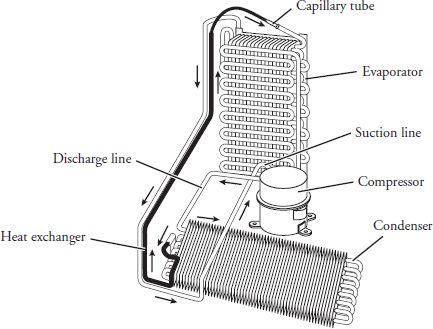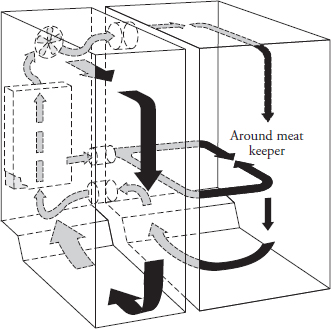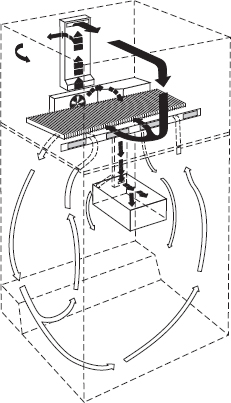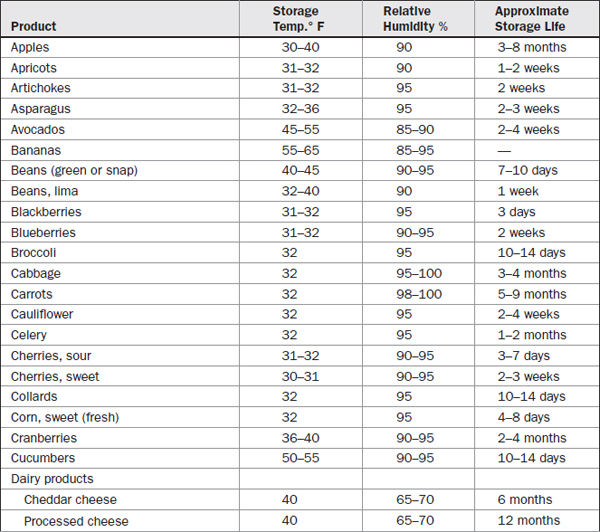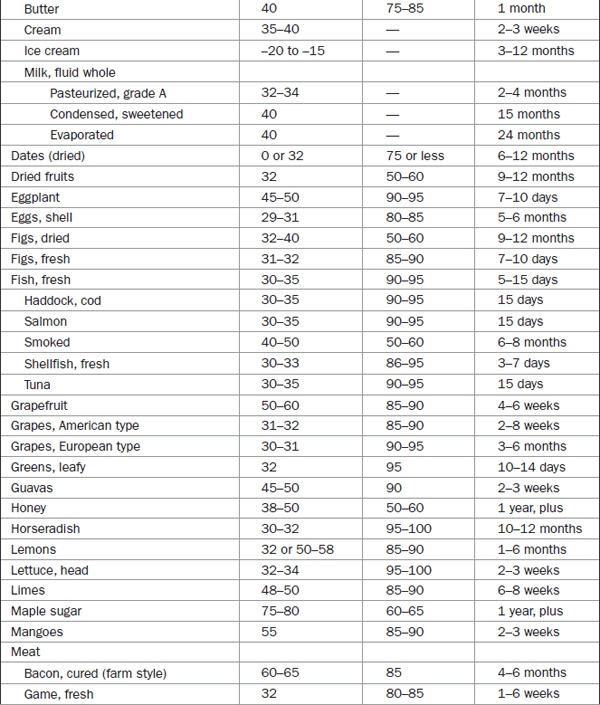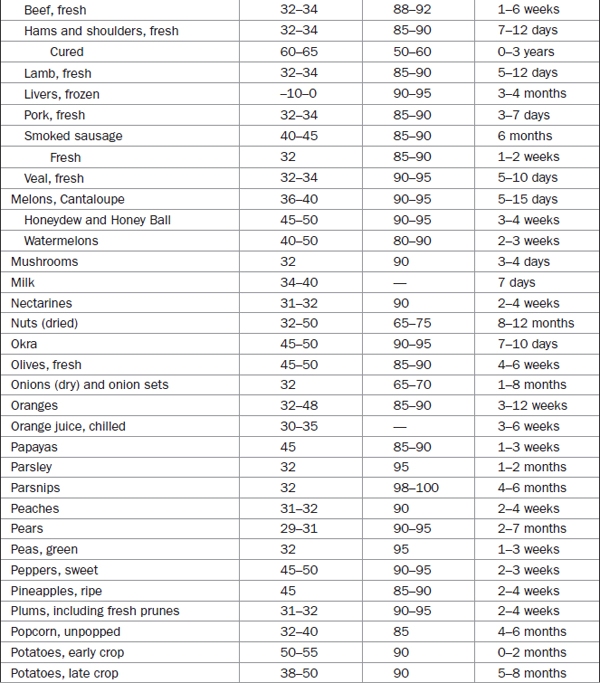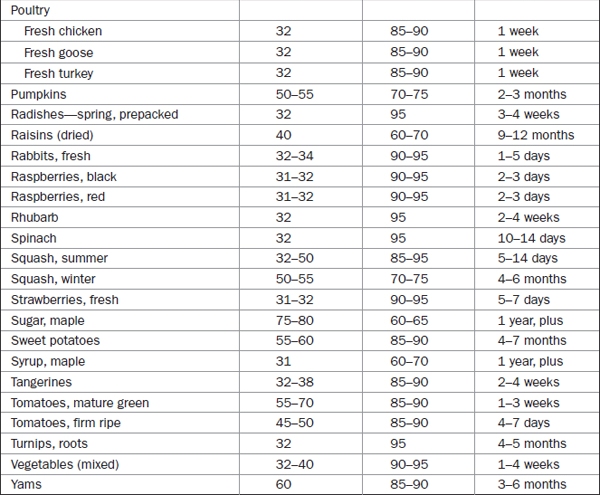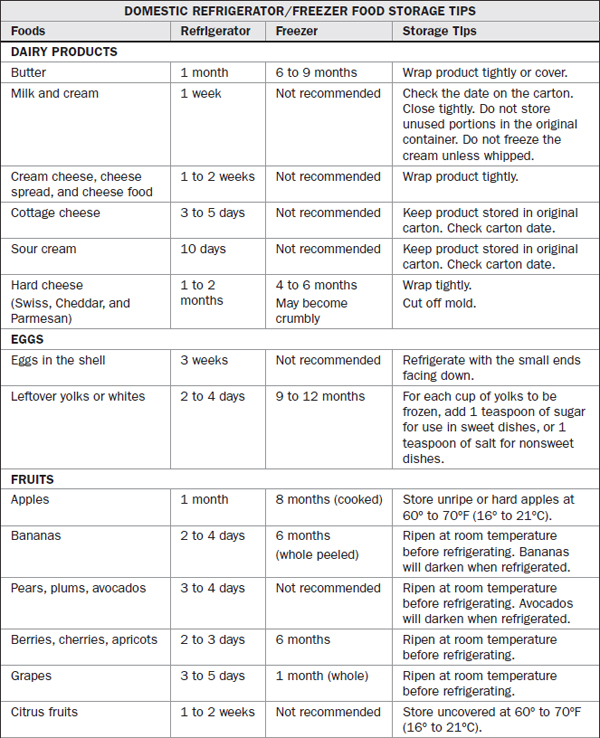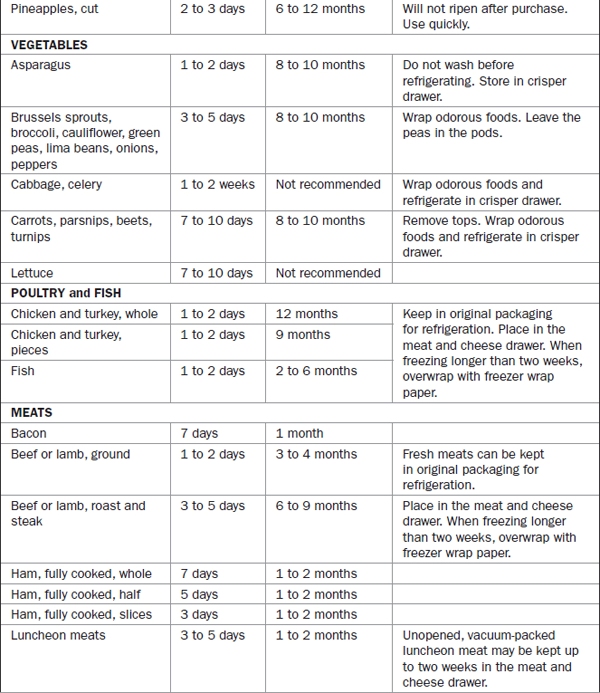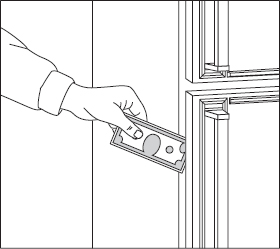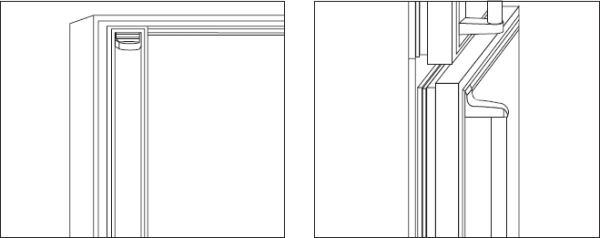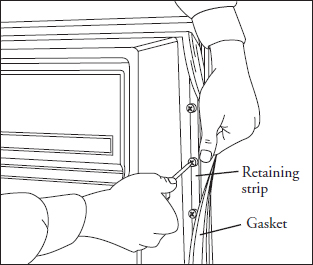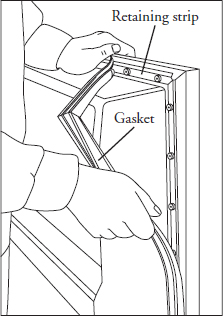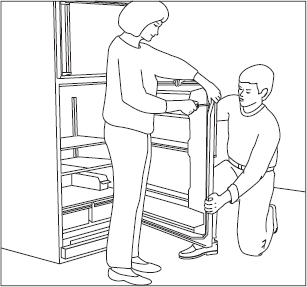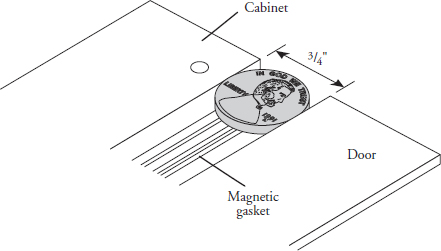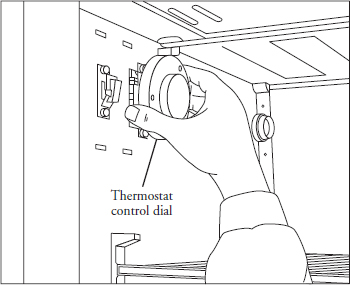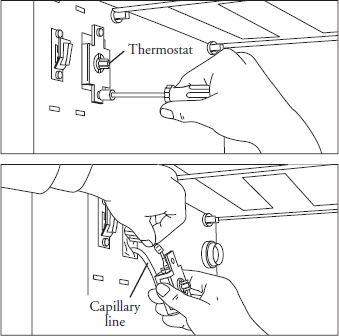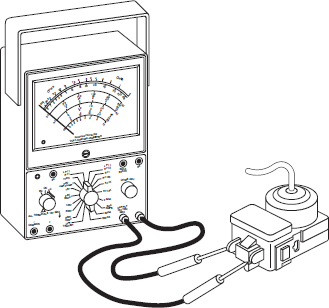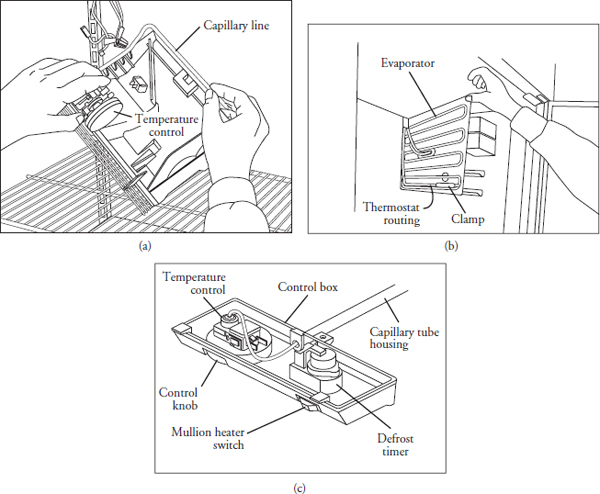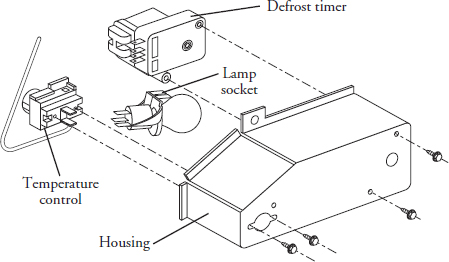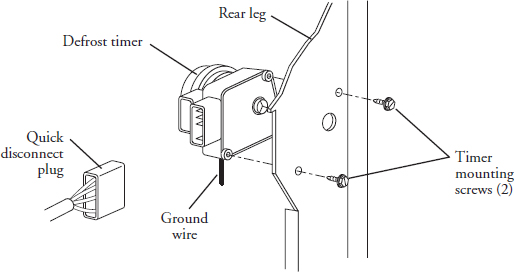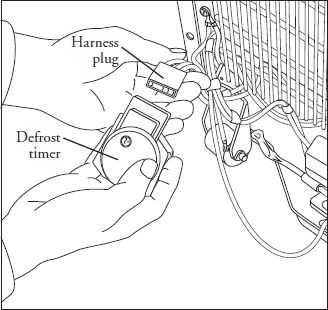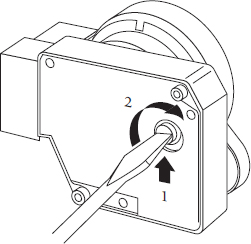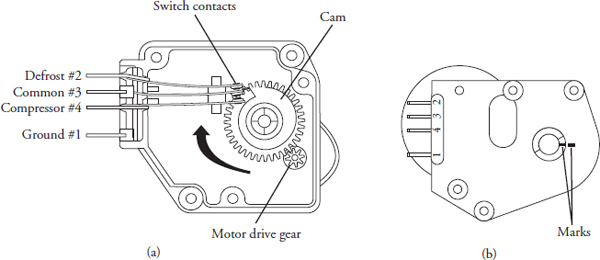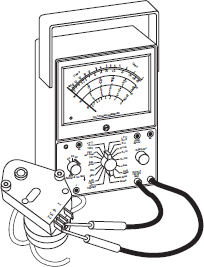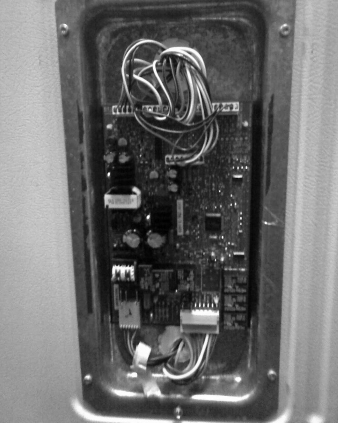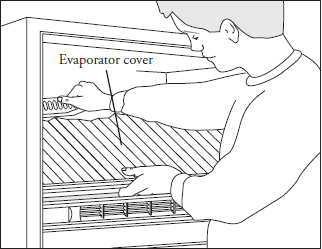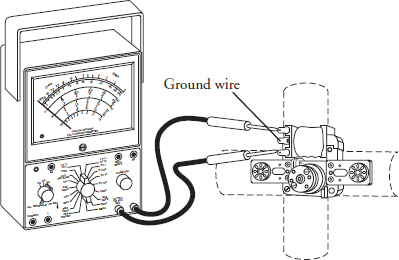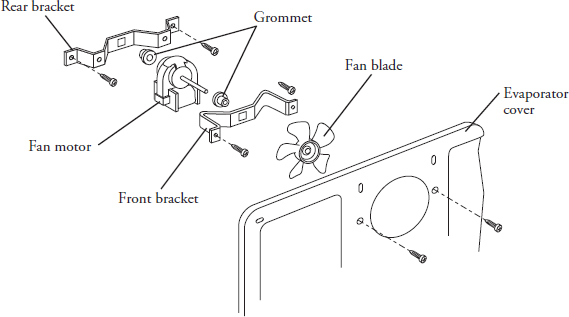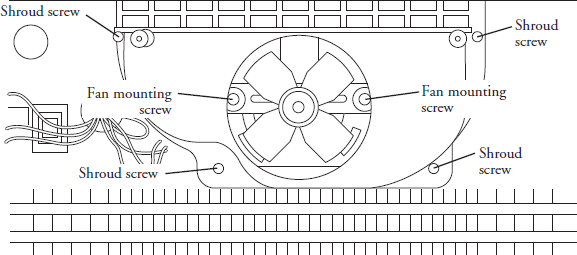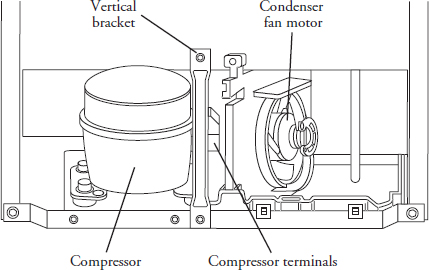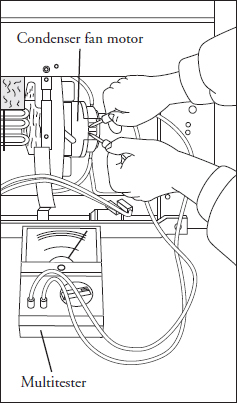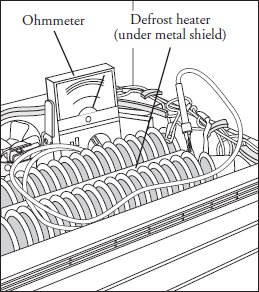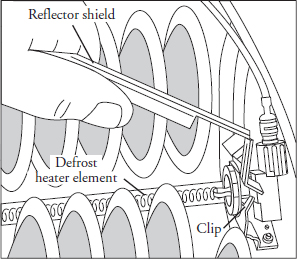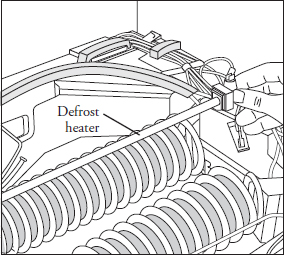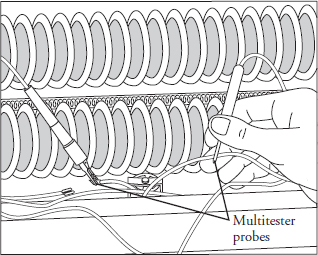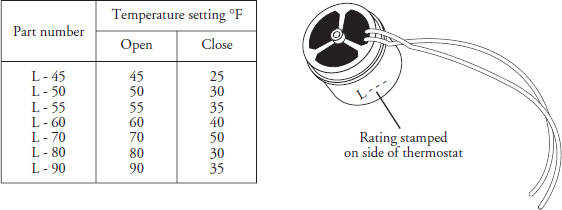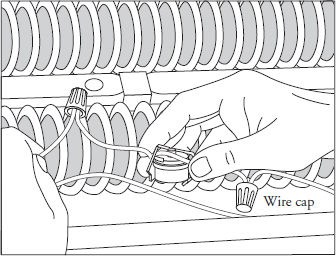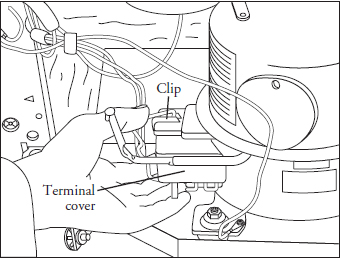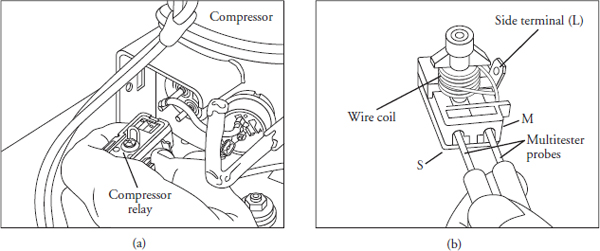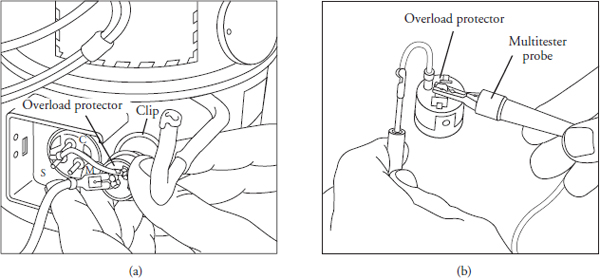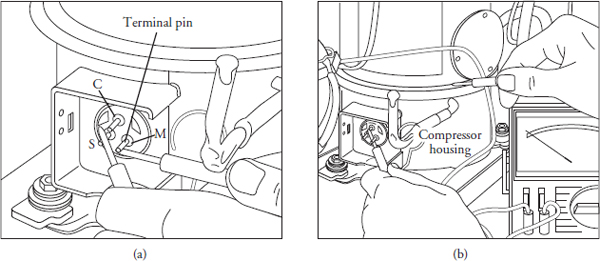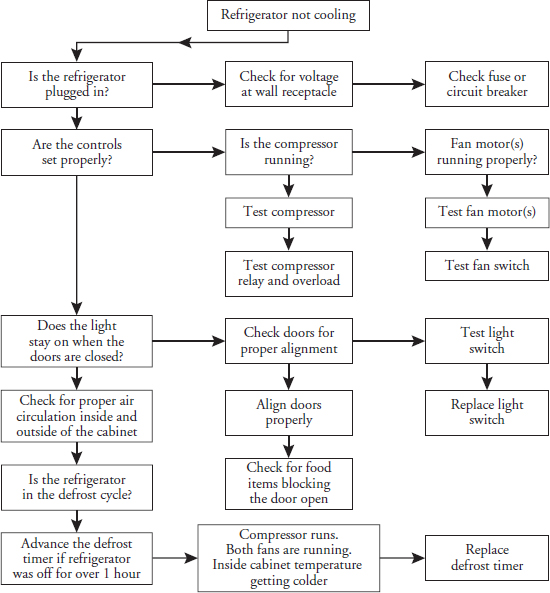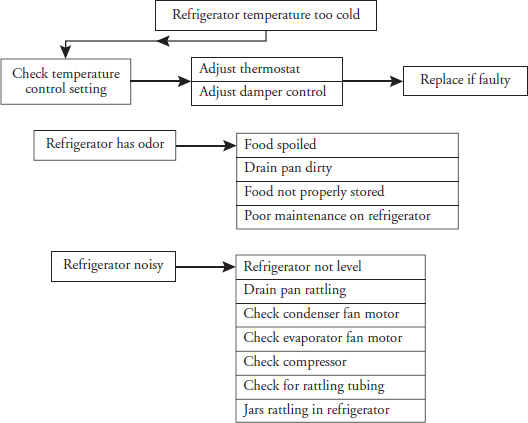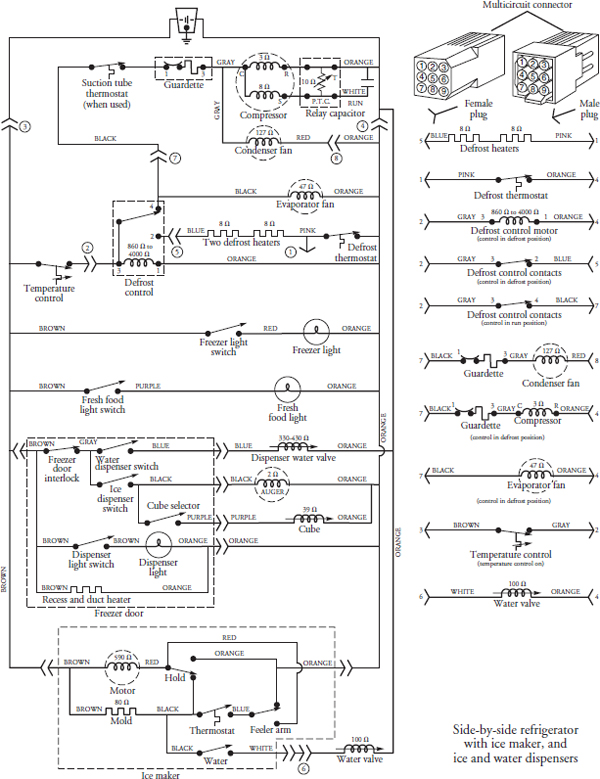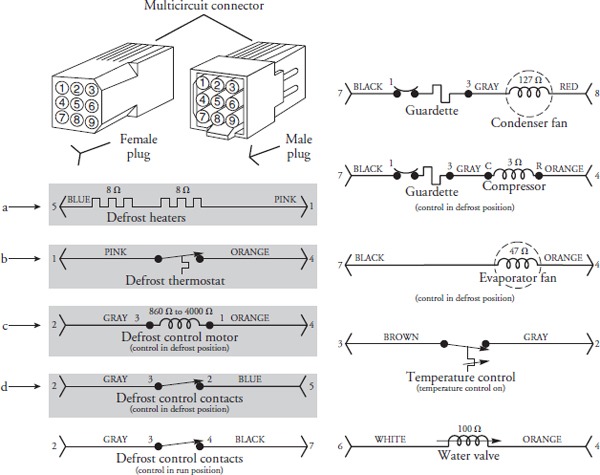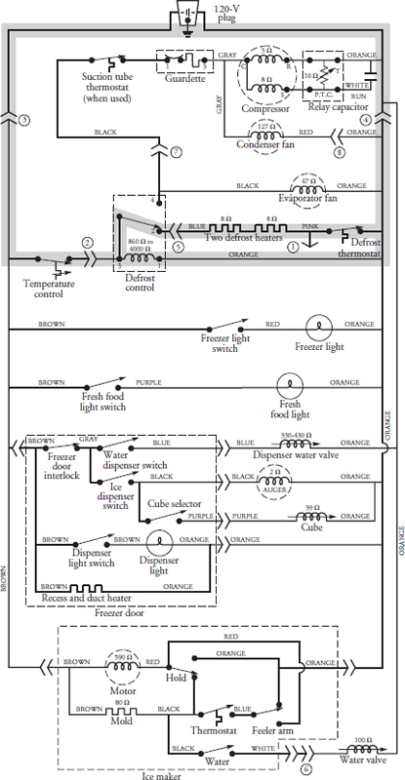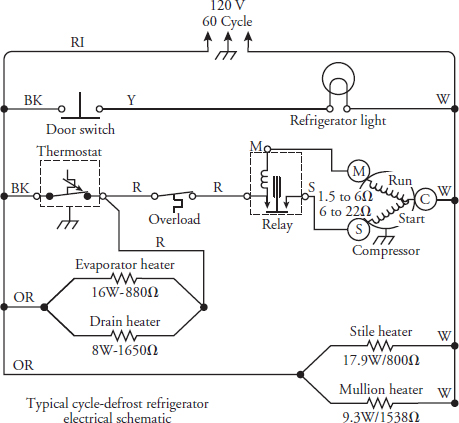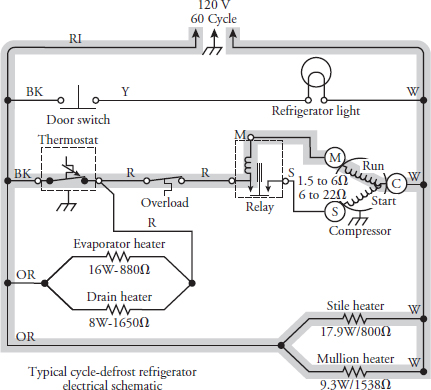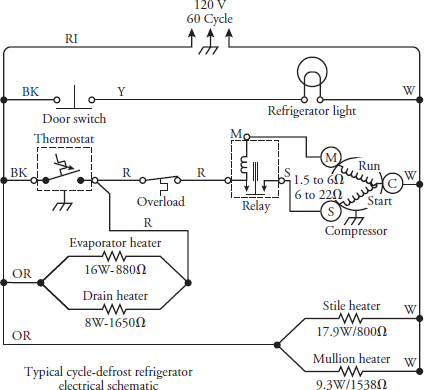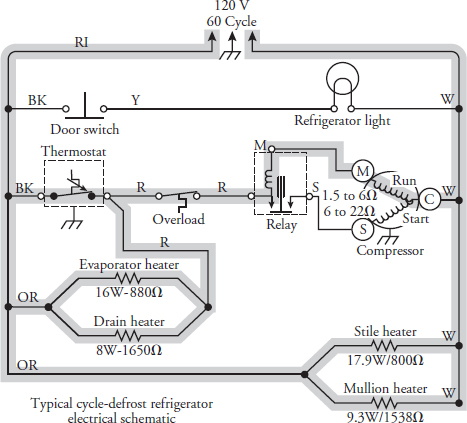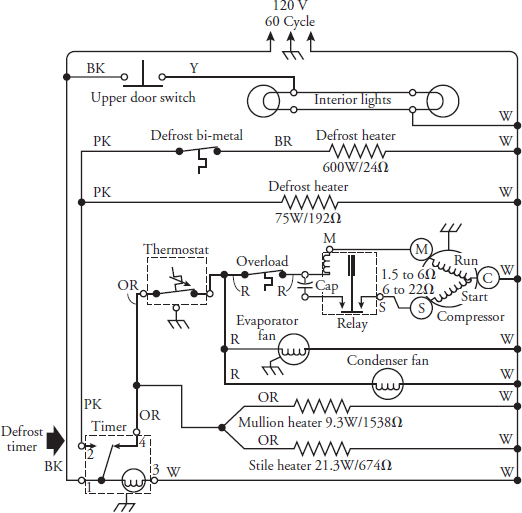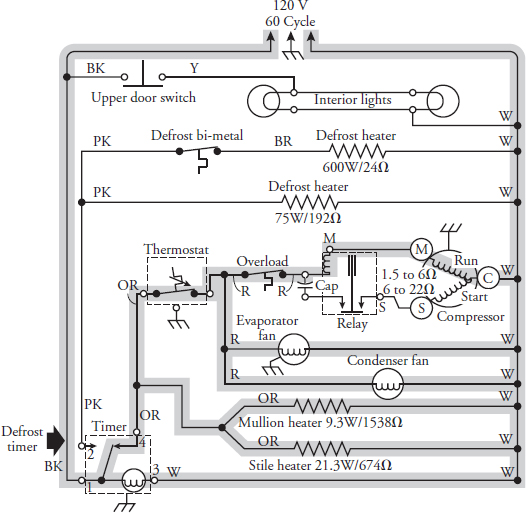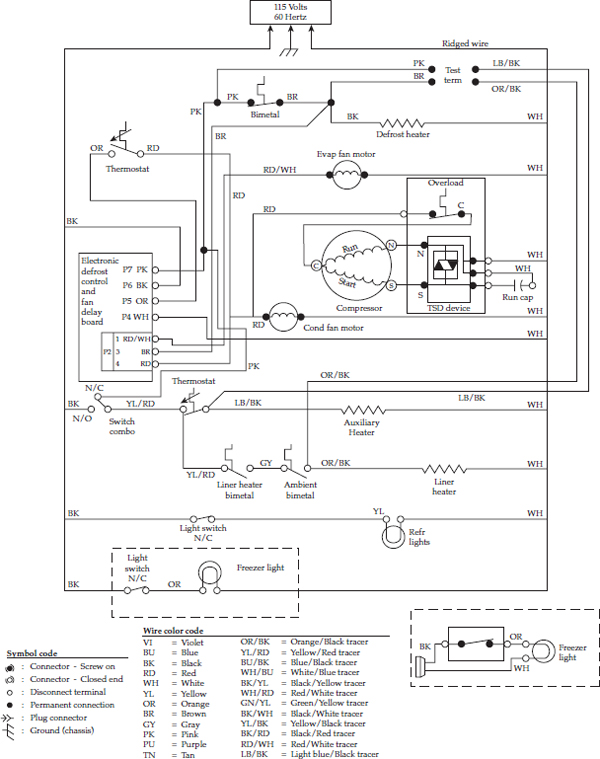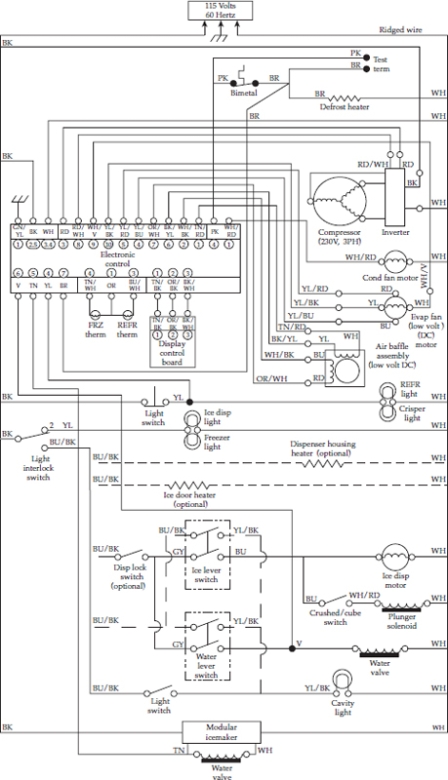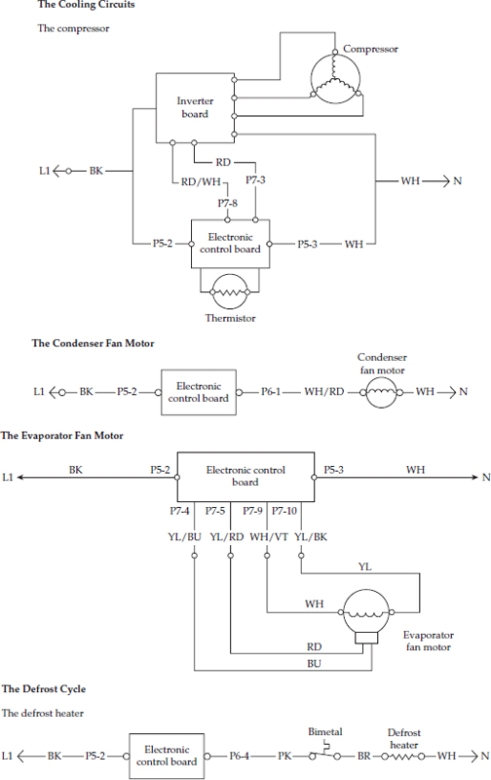25
CHAPTER
Refrigerators
One of the most important applications of refrigeration (which was invented in the early 1900s) was for the preservation of food. When different types of food1 are kept at room temperature, some of them will spoil rapidly. When foods are kept cold, they will last longer. Refrigerators prevent food spoilage by keeping the food cold.
The refrigerator consists of three parts:
• The cabinet.
• The sealed system, which consists of the evaporator coil, the condenser coil, the compressor, and the connecting tubing.
• The electrical circuitry, including fan motors and other electrical components.
This chapter covers the electrical components and how to diagnose the sealed system. The actual repair or replacement of any sealed-system component is not included in this chapter. It is recommended that you acquire refrigerant certification (or call an authorized service company) to repair or replace any sealed-system component. The refrigerant in the sealed system must be recovered properly.
The Refrigeration Cycle
The sealed system (Figure 25-1) in a refrigerator consists of a compressor, a condenser coil, an evaporator coil, a capillary tube, and a heat exchanger and its connecting tubing. This is the heart of the refrigerator that keeps the food cold inside the cabinet.
FIGURE 25-1 The sealed-system components in a side-by-side refrigerator.
Starting at the compressor, refrigerant gas is pumped out of the compressor, through the discharge tubing, and into the condenser coil. When the gas is in the condenser coil, the temperature and pressure of the refrigerant gas greatly increase because of the capillary tube at the discharge end of the condenser coil. From the surface of the condenser coil, the heat spreads out into the room via air moving over the condenser coil. The condenser coil cools the hot refrigerant gas. As the refrigerant gas gives up the heat it obtained from inside the refrigerator cabinet, the refrigerant gas changes into a liquid. This liquid then leaves the condenser coil and enters the capillary tube.
This capillary tube is carefully made with regard to its length and inside diameter to meter out the exact amount of liquid refrigerant through the sealed system (this is designed by the manufacturer for a particular size and model). As the liquid refrigerant leaves the capillary tube and enters the larger tubing of the evaporator coil, the sudden increase of tubing size causes a low-pressure area. It is here that the liquid refrigerant changes from a liquid to a mixture of liquid and gas.
As this mixture passes through the evaporator coil, the refrigerant absorbs heat from the warmer items (food) within the refrigerator cabinet, slowly changing any liquid back to gas. As the refrigerant gas leaves the evaporator coil, it returns to the compressor through the suction line.
This entire procedure is called a cycle. Depending on where the cold control (thermostat) is set, the thermostat can show how cold it is inside the cabinet and then control the actuation of the cooling cycle. It will determine whether to turn the system on or off to maintain the temperature within the cabinet.
Inside the cabinet, the cold air is circulated by convection and/or by means of an electrical fan. In Figure 25-2, the arrows show the airflow patterns in this type of side-by-side refrigerator. Figure 25-3 shows the air patterns in a two-door refrigerator with a top freezer.
FIGURE 25-2 The airflow pattern in a side-by-side refrigerator.
FIGURE 25-3 The airflow pattern in a two-door refrigerator with top freezer.
Refrigerator Automatic Defrost Systems
Over the years manufacturers have developed many methods to defrost the evaporator coil. Maintaining proper moisture control within the refrigerator is crucial for proper efficient operation. Every time the consumer opens the door, moisture and heat enter the refrigerator compartment. Through either natural convection or forced-air movement, the moisture will eventually condense on the coldest spot in the refrigerator: the evaporator coil. The evaporator coil is well below the freezing temperatures, and the condensed moisture will stick to it and begin to freeze. As frost accumulates on the evaporator coil, the airflow through the evaporator coil will begin to decease and the cooling effect will also decrease.
The manual method for defrosting an evaporator coil will be time consuming, and most consumers end up destroying the evaporator coil by punching a hole in it with an ice pick or a knife. Manufacturers have developed the automatic defrost system. Most modern-day refrigerators have a timer to activate the defrost cycle. A heater element and a defrost termination thermostat have also been attached to the evaporator coil to defrost the frost buildup. When the timer calls for the defrost cycle, the sealed system is de-energized and the heater is energized. The defrost termination thermostat monitors the temperature of the evaporator coil; at around 40 to 60 degrees Fahrenheit the thermostat will turn off the heater. The defrost timer will stay in the defrost mode for up to 30 minutes, regardless of whether the frost is melted or not. The water that results from the defrost process will be directed to the evaporator drain pan and then redirected to the outside of the refrigerator to the condensate pan at the base of the refrigerator to be evaporated.
Some refrigerator models use a defrost cycle on a timed schedule. That means approximately every six to eight hours, the defrost cycle is turned on for approximately 28 to 30 minutes. This type of defrosting system runs without regard for the actual cooling demand on the sealed system. A more efficient type of defrost system developed by manufacturers is the cumulative run-time defrost system. This type of system is based on the compressor run time. The defrost timer only advances when the compressor run time has equaled a predetermined amount of run time; then the system will enter into a defrost time. One disadvantage of this type of defrost system is it does not account for the number of times the door is opened and the increased humidity enters the refrigerator compartment.
Manufacturers over time have developed a new type of automatic defrost system: the adaptive automatic defrost system. With the decreased cost of electronic components a better way has been developed to control the defrost frequency. This type of system measures the time it takes from the start of the defrost cycle until the defrost termination thermostat opens. This type of system is known as adaptive defrost.
Depending on the manufacturer, the first defrost time will occur between six to eight hours of cumulative compressor run time. The adaptive defrost control (ADC) will continually adjust the defrost intervals based on the following:
• Number of door openings.
• Compressor run time.
• The last defrost cycle.
During the defrost cycle, the ADC monitors how long the defrost termination thermostat keeps the heater energized. If the defrost termination thermostat opens in under 12 minutes, this is equal to a light frost buildup. The ADC will increase the amount of compressor run time between defrost times by two hours. If the defrost termination thermostat opens in over 12 minutes, this is equal to a heavier frost buildup. The ADC will decrease the amount of compressor run time between defrost times by two hours.
Over the course of several defrost cycles, the time between the start of the defrost cycle and the opening of the defrost termination thermostat will get closer to the ideal defrost time. The ADC has adjusted the amount of run time between defrosts to occur often enough to maintain a clean evaporator coil, but not so often as to use excessive energy. As humidity conditions change and the frost load increases or decreases, the ADC will adjust the cumulative run time to match the change in the frost load.
As mentioned earlier, not all refrigerator manufacturers use this process. They use a slightly different algorithm programmed into the ADC computer chip, but the principle of operation for most of these ADC controls is very similar. The service technician will need the wiring diagram and/or the service manual for the model they are servicing to properly diagnose and be able to turn on the defrost mode on the ADC board.
Another type of defrost system is the hot gas defrost system. This type of system is seldom used in residential refrigerators due to the additional cost of components. The hot gas defrost systems are used in commercial ice machines to aid in the harvesting process of ice. In the residential refrigerator, a bypass valve is added to the sealed system to the condenser at a point before the refrigerant begins to condense into a liquid state. When defrost is called for, the valve will open, and the hot gas enters the evaporator after the capillary tube inlet. The hot gas will thaw the frost from the evaporator coil.
A cycle defrost system is used on inexpensive refrigerators. The freezer evaporator is manual defrost, but the refrigerator evaporator is defrosted every time the compressor cycles off. In this type of system a special thermostat and two low-wattage heaters are used to defrost the evaporator.
Storage Requirements for Perishable Products
Table 25-1 lists the recommended storage temperatures, relative humidity, and the approximate storage life for perishable products. These values are used in designing commercial refrigeration systems, which house large quantities of perishable products.
TABLE 25-1 Storage Requirements for Perishable Products for Commercial Refrigerators and Freezers
Large warehouses are usually equipped to store foods at those temperatures best adapted to prolonging the safe storage period for each type of food. In the domestic refrigerator, most foods are kept at 34 to 40 degrees Fahrenheit (1 to 4 degrees Celsius) with an optimum temperature of 37 degrees Fahrenheit, and the humidity is kept around 50 percent. The freezer temperature is between zero and minus 10 degrees Fahrenheit (−17 to −23 degrees Celsius).
It can be difficult to maintain these temperatures and humidity for each individual product. Therefore, refrigerator manufacturers have designed separate compartments within the refrigerated cabinet to maintain a variable temperature and humidity selected by the consumer. The storage life of various products will vary in a domestic refrigerator/ freezer (Table 25-2). This period will be influenced by many factors, such as the storage temperature, the type of container, the condition of the food, and the kind of food. For food storage tips, consult the use and care guide.
TABLE 25-2 Storage Requirements for Perishable Products for a Domestic Refrigerator/Freezer
To test the temperature in a refrigerator/freezer, place a thermometer in a glass of water and place it in the center of the refrigerator compartment. After 24 hours, check the thermometer. To test the temperature in the freezer compartment, place a thermometer between two frozen packages. After 24 hours, check the thermometer. If the temperature controls needs to be readjusted, retake temperatures as listed earlier.
Safety First
Any person who cannot use basic tools or follow written instructions should not attempt to install, maintain, or repair any refrigerators. Any improper installation, preventive maintenance, or repairs could create a risk of personal injury or property damage.
If you do not fully understand the installation, preventive maintenance, or repair procedures in this chapter, or if you doubt your ability to complete the task on your refrigerator or freezer, please call your service manager.
Before continuing, take a moment to refresh your memory of the safety procedures in Chapter 2.
Refrigerators in General
Much of the troubleshooting information in this chapter covers refrigerators in general, rather than specific models, in order to present a broad overview of service techniques. The illustrations in this chapter are for demonstration purposes only, to clarify the description of how to service these appliances. They in no way reflect on a particular brand’s reliability.
Location and Installation of Refrigerator
Thoroughly read the installation instructions that are provided with every new refrigerator. These instructions will provide you with the information you need to properly install the refrigerator. The following are some general principles that should be followed when performing the installation:
• The refrigerator must be installed on a solid floor capable of supporting the product up to 1000 pounds.
• For proper air circulation around the refrigerator, some models require a one-inch clearance at the rear and top of the cabinet and adequate clearance near the front grille at the bottom of the refrigerator.
• Do not leave the refrigerator on its side longer than necessary to remove the shipping base.
• When removing or reversing the doors on a refrigerator, always reinstall them according to the installation instructions, and remember to realign the doors properly.
• Level the refrigerator cabinet so that the doors close properly.
What’s That “Different” Sound in Your Kitchen?
If you have bought or serviced a new refrigerator within the past few years, you’ve probably noticed that it sounds “different.” Here’s why: New refrigerators use only half as much electricity as the older models. In fact, a new 20.6-cubic foot refrigerator with top freezer uses no more electricity than a 75-watt light bulb. Most new refrigerators are also larger, and they have such added conveniences as automatic defrost systems, ice makers, and perhaps even a “built-in” look. These new features result in different sounds, such as:
• High-pitched whine This is due to the more energy-efficient compressors that have smaller, higher-speed motors.
• Soft hum This is from the evaporator fan in the freezer and/or from the condenser fan under the refrigerator.
• Clicks These can be from the automatic defrost timer switching on and off, the thermostat turning the refrigerator on and off, or the water valve refilling the ice maker.
• Boiling and/or gurgling or trickling water When the refrigerator stops running, the refrigerant continues to circulate within the system or the defrost water runs into the drain pan.
• Running water and “thuds” These sounds occur as the ice cube tray fills and as the ice cubes drop into the storage bin.
To help mute these new sounds:
• Be sure that the refrigerator is level and that the defrost water collection pan is in position (usually reachable behind the bottom front “toe plate”).
• Put a piece of carpet or a sound-absorbing ceiling tile on the wall behind the refrigerator.
• Allow enough space between the back of the refrigerator and the wall, unless it is designed as a “built-in” unit. Check your use and care manual for the needed space.
To reduce the compressor run time:
• Vacuum the condenser coils at least twice a year—more often if you have pets.
• Keep your freezer at least three-fourths full. Use partially filled water jugs to fill any large empty space.
The Major Appliance Consumer Action Panel, or MACAP, was an independent complaint-mediation group made up of professionals with expertise in textiles, equipment, consumer law, and engineering who volunteered their time. Unfortunately, MACAP went out of business in the last few years, but the information that is printed in this book is still valuable and worth reading for guidance. If you are experiencing any problems with your product or service company, contact your local Better Business Bureau (BBB).
Many of the consumers who filed “refrigerator sound” complaints with the MACAP represent one- or two-family households; they have recently moved to smaller retirement homes; or they have remodeled, and the kitchen is now open to a family living area. Sounds are more noticeable in quieter surroundings. Consumers with hearing aids are especially sensitive.
Some consumers reported to MACAP that their refrigerators are “louder” than an identical model in a friend’s or a relative’s house. This might be because of the number of people in the house, as well as different furnishings and room arrangements. Carpeting, drapery, upholstered furniture, and wall coverings can help to muffle refrigerator sounds.2
Are Refrigerators/Freezers Snowbirds?
Putting that extra refrigerator or freezer in any area in which the temperature falls below 60 degrees Fahrenheit might be a problem in colder areas when the winter months are approaching. Combination refrigerator/freezers and freezers with automatic defrost systems are sensitive to the ambient air temperature surrounding them. As this ambient temperature rises, the compressor runs more to maintain the storage temperature in the fresh food and frozen food compartments, thus wasting energy. As the ambient temperature falls, compressor operation decreases.
When temperatures fall below 60 degrees Fahrenheit, the compressor will not operate long enough to maintain low storage temperatures in the freezer compartment. This is because the fresh food compartment contains the primary sensor, and it is satisfied quickly at a low ambient temperature. The lower the temperature goes, the worse this condition becomes. At about 38 to 42 degrees Fahrenheit, the compressor will not run at all. The freezer compartment temperature will increase to the ambient room temperature, and the frozen food in the compartment will defrost and spoil.
Combination refrigerator/freezers and automatic-defrost freezers should not be operated in unheated places, like garages or porches, where room temperatures are likely to drop below 60 degrees Fahrenheit, unless they are specifically designed for operation in low temperatures. Check the manufacturer’s use and care manual for the lowest safe operating temperature.
At any time the temperature will be less than 60 degrees Fahrenheit, it is best to empty the freezer compartment of the refrigerator/freezer in order to prevent defrosting and the possible spoilage of frozen foods. You might want to consider removing all of the food from the unit, turning it off, and propping the door open if you will be absent for an extended period of time. The door must stay open to prevent mold and odor. Don’t do this if your refrigerator has a latch-type handle (pre-1958 model) because of the potential for child entrapment.
Manual-defrost freezers can usually be operated in an unheated garage or porch without affecting the unit or the frozen food. However, check the use and care manual to determine if your unit needs special care.3
“Freezer” in Single-Door Refrigerator Has Limited Function
“I just bought a single-door refrigerator and my ice cream won’t harden. It’s like cold soup,” a consumer recently complained to MACAP. “If I turn the temperature control to a colder setting, the food in the refrigerator section freezes, but the ice cream remains soup. Something’s wrong with the freezer.”
Approximately 6 percent of all refrigerators sold each year are “single-door” models. That is, the model has only one outside door. Inside (usually across the top or to one side) is a small freezer compartment with its own door. Most combination refrigerator/freezers have two or more doors on the outside, providing independent access to separate freezer or refrigerated sections.
In the course of investigating this consumer’s complaint, MACAP found that consumers have reason to be confused about the capabilities of “single-door” refrigerators. Many manufacturers refer to the separate frozen food compartment as a “freezer section,” as a “freezer compartment,” or as a “freezer” in their specification literature. MACAP found that a majority of consumers expect to be able to keep such hard-to-freeze items as ice cream and orange juice in this “freezer” compartment. These items have a high sugar content, and they freeze at lower temperatures than water.
The Association of Home Appliance Manufacturers (AHAM), in its nationally accepted standard, calls such a unit a “basic refrigerator” and specifies that it is “intended for short-term storage of foods at temperatures below 32 degrees Fahrenheit and normally above 8 degrees Fahrenheit.” However, most newer models have temperatures at (or near) freezing level, which is not adequate to freeze foods. Distilled water freezes at 32 degrees Fahrenheit, but all frozen foods must be stored at a temperature lower than that to freeze. Vegetables begin to freeze at 29 to 31 degrees Fahrenheit, meats at 25 to 29 degrees Fahrenheit, and orange juice concentrate at about 8 degrees Fahrenheit. Ice cream begins to stiffen at 27 degrees Fahrenheit, but is considered at an ideal hardness for scooping at 8 degrees Fahrenheit.
If reference is made to the compartment being a “food freezer” or a “frozen food storage compartment” (as in double-door units), the consumer can expect that it will store already frozen foods for several days, or even months, without deterioration. However, a “freezer section” or “freezer compartment,” as found in single-door refrigerators, might only freeze ice cubes.
MACAP recommends that consumers determine their food freezing needs and carefully read available literature before making a purchasing decision.4
Refrigerator Maintenance
The inside of the cabinet should be cleaned at least once a month to help prevent odors from building up. Of course, any spills that might happen should be wiped up immediately. Wash all removable parts by hand with warm water and a mild detergent; then rinse and dry the parts. The inside walls of the cabinet, the door liners, and the gaskets should also be washed using warm water and a mild detergent, rinsed, and dried. Never use cleaning waxes, concentrated detergents, bleaches, ammonia, or cleansers containing petroleum products on plastic parts. Never use cleaning products with a lemon scent; the lemon will be absorbed into the liner permanently and it may also affect the food. On the outside of the cabinet, use a sponge with warm water and a mild detergent to clean dust and dirt. Then rinse off and dry thoroughly.
At least two times a year, the outside cabinet should be waxed with an appliance wax or with a good auto paste wax. Waxing painted metal surfaces provides rust protection. The defrost pan, which is located behind the toe plate or behind the cabinet, should be cleaned out once a month. The condenser coil should also be cleaned of dust and lint at least once a month. The floor should be free of dirt and debris when the cabinet is rolled out away from the wall. After the cabinet is rolled back into place, you must check to be sure that the cabinet is level.
Food Odors and Molds
Odors in the refrigerator compartment or the freezer compartment cannot occur by themselves. The only way that odors can occur is by storing foods in an unsealed container or unwrapped. Another way that odors occur is from food spillage or from rotten or spoiled food. In new refrigerators there may be a plastic odor, but this is normal and it will dissipate in time. Here are some more tips to help in odor removal:
1. Place a box of baking soda in the refrigerator’s fresh food and freezer compartments. Replace according to the instructions on the box.
2. Place some activated charcoal in a shallow metal pan inside the fresh food or the freezer compartment of the refrigerator. When the charcoal loses its effectiveness, place the metal pan in the oven and heat it on a low temperature for a couple of hours to rejuvenate it. Do not use charcoal briquettes used for grilling; it is not the same activated charcoal.
3. Place some vanilla extract in a small dish and place in the refrigerator’s fresh food compartment for three weeks. Do not place in the freezer compartment; the vanilla extract will freeze and be ineffective.
On occasion the ice cubes will have a bad taste and will smell like food. Sometimes, the food odors come from the refrigerator compartment. To be able to tell which storage compartment is producing the food odors, try the following:
1. Fill ice trays with tap water and freeze them.
2. Remove the ice cubes from the tray and place in a bowl.
3. Place a bowl in the freezer compartment for a few days.
4. Taste or smell the ice cubes.
If the taste or odor is present in the ice cubes, then the odors are coming from the refrigerator or freezer compartment. The odors are present in the air and as they circulate between the two compartments, the ice cubes absorb the odors. If the bowl of ice cubes has no odors or bad taste, then the bad taste and odor are coming from the water supply that feeds the automatic ice maker and/or water dispenser. Once every two or three weeks, replace the old ice cubes with new ones.
Food molds often grow on baked goods, produce, and leftovers and dairy products. Mold is caused by microbes that attach to the food surface and causes the food to go bad. Underneath the food’s surface the mold cells attack the remainder of the food, causing it to rot out.
As food is stored in the refrigerator it loses taste, texture, and nutritional value. Improper handling or storing of foods can cause food-related illness or even disease. To clean the mold from the refrigerator, throw away spoiled food, and clean the walls and shelves in the refrigerator and freezer compartments. Follow the use and care instructions that came with the refrigerator for proper cleaning instructions.
Step-by-Step Troubleshooting by Symptom Diagnosis
When servicing an appliance, don’t overlook the simple things that might be causing the problem. Step-by-step troubleshooting by symptom diagnosis is based on diagnosing malfunctions, with possible causes arranged into categories relating to the operation of the refrigerator. This section is intended only to serve as a checklist to aid you in diagnosing a problem. Look at the symptom that best describes the problem you are experiencing with the refrigerator, and then correct the problem.
The Refrigerator Does Not Operate
• Check and see if the refrigerator is plugged in.
• Check voltage at receptacle.
• Check the temperature controls. Are they off?
• Check the electronic control board. Run the test mode.
Compressor Will Not Run
• Is there voltage at the wall receptacle? Check this with the voltmeter.
• Check for loose electrical connections.
• Is the condenser coil dirty? A dirty condenser coil will overheat the compressor.
• Check the condenser fan motor.
• Test the cold control for continuity.
• Test the compressor, the relay, and the overload switch.
• Check and see if the refrigerator is in the defrost mode.
Compressor Kicks Out on Overload
• Check for high or low voltage when the compressor tries to start. High voltage will overheat the compressor. Low voltage will try to run the compressor with the start winding. A compressor is designed to start and run within a 10 percent tolerance of the rated voltage.
• Test the capacitor. A shorted or open capacitor will overheat the compressor.
• Test the compressor relay.
• Test the overload for continuity.
• Test the compressor windings for a short.
Refrigerator Is Too Cold
• Check the damper control setting. Check to see if the damper is stuck open (thermostatically controlled dampers only).
• Test the cold control switch contacts for continuity. Test for stuck contacts.
• Check temperature sensors.
• Check the location of the refrigerator. If outside in the winter, the ambient temperature may be too cold.
Refrigerator Is Too Warm
• Check for restricted air circulation around the condenser coil.
• Check the location of the refrigerator.
• Check the door gaskets for proper sealing.
• Check to see if the cabinet light is staying on when the door is closed.
• Check the defrost heaters. Use a clamp-on ammeter (or wattmeter) to test the heaters if they are coming on when the refrigeration cycle is running.
• Check the cold control setting.
• Check the compressor. Is it operating properly?
• Is the evaporator fan running?
• Check the air duct for restriction.
• Check temperature sensors.
• Check for a leaking air duct.
• Check the evaporator coil for excessive frost buildup.
• Check the defrost cycle. Is it working properly?
• Check the damper control setting. Check to see if the damper is stuck closed (thermostatically controlled dampers only).
Refrigerator Is Too Noisy
• Check for loose parts.
• Check for rattling pipes.
• Check the fan assembly the evaporator, and the condenser.
• Check the compressor.
• If these are normal operational noises, inform the consumer.
• Refrigerator not properly leveled.
• Check the floor—it may not be structurally sound.
Sweating on the Outside of the Cabinet
• Check the location of the refrigerator. If located in an area of high humidity, it will sweat.
• Check for a void in the insulation between the cabinet and the inner liner.
• Test the mullion and/or stile heaters for continuity.
• Is the energy saver switch in the “on” position?
• On older models, check for wet insulation.
• Check for suction line or any low side tubing touching the cabinet.
• Check for water leaks from the ice maker.
• Check chilled water supply lines and connections.
• Check for a kinked, misaligned, or blocked drain system.
• Check the defrost drain pan for misalignment or for leaking cracks.
• Are the doors aligned and sealing properly?
Sweating on the Inside of the Cabinet
• Check for any abnormal usage. Instruct the consumer on proper usage.
• Check the door gaskets for proper sealing.
• Check for defrost drain water leaking into the cabinet.
• Is the condensate drain blocked?
• Are the doors aligned properly?
• Inspect all access holes where tubing or wires enter the refrigerator/freezer.
• Seal with Permagum if necessary.
• Inspect cabinet outer walls and seams for any openings. Seal with Permagum if necessary.
• Are there excessive door openings on hot, humid days?
• Check for improper food storage.
Incomplete Defrosting of the Evaporator Coil or High Temperature During the Defrost Cycle
• Test the defrost thermostat.
• Check for loose wiring in the defrost electrical circuit.
• Test the defrost timer for continuity.
• Test for defective defrost heaters.
Odor in Cabinet
• Check for spoiling food in the cabinet.
• Check the defrost water drain system.
• Check the defrost heaters.
Excessive Frost Buildup on Evaporator Coil in the Freezer Section
• Check the defrost cycle.
• Check for loose wiring.
• Is the heater making contact with the evaporator coil?
• Check for proper door alignment.
• Check the door gaskets.
Freezer Section Run Time Is Too Long
• Check the thermostat setting.
• Check for excessive loading of unfrozen food.
• Check for incorrect wiring.
Temperature in Freezer Section Is Higher Than Normal
• Check the thermostat for proper temperature calibration.
• Test evaporator fan motor and blade.
• Check the defrost timer.
• Check for excessive loading of unfrozen food.
• Check door gasket for proper sealing.
Refrigerator Runs Excessively or Continuously
• Check if the interior lights are staying on continuously.
• Check condenser coil for air restriction.
• Check door gaskets.
• On models with automatic ice makers, make sure the ice maker is operating properly.
Temperature-Controlled Drawers Are Too Warm
• Check control settings.
• Check the freezer control; it may be set too low.
• Check that the drawer is not improperly positioned.
Troubleshooting Sealed-System Problems
If you suspect a sealed-system malfunction, be sure to check all external factors first.
These include:
• Thermostats
• Compressor
• Relay and overload on the compressor
• Interior lights
• Evaporator and condenser fans
• Timers
• Refrigerator/freezer getting good air circulation
• Food loaded in the refrigerator/freezer properly
• Check if heat exchanger has separated
• Check the wiring harness
After eliminating all of these external factors, you will systematically check the sealed system. This is accomplished by comparing the conditions found in a normally operating refrigerator/freezer. These conditions are:
• Refrigerator/freezer storage temperature
• Wattage
• Condenser temperature
• Evaporator inlet sound (gurgle, hiss, etc.)
• Evaporator frost pattern
• Pressure equalization time
One thing to keep in mind is that no single indicator is conclusive proof that a particular sealed-system problem exists. Rather, it is a combination of findings that must be used to definitely pinpoint the exact problem.
Refrigerant Leak
The following symptoms may indicate there is a refrigerant leak in the sealed system:
• Temperatures in the storage area are below normal.
• The wattage and amperage are below normal, as indicated on the model/serial plate.
• The condenser coil will be cool to the touch at the last pass or even as far as midway through the coil.
• At the evaporator coil, you will hear a gurgling noise, a hissing noise, or possibly an intermittent hissing or gurgling noise.
• When the evaporator coil cover is removed, the evaporator coil will show a receded frost pattern.
• The high- and low-side pressures will be below normal.5
• The pressure equalization time might be normal or shorter than normal.
Overcharged Refrigerator
If the sealed system is overcharged, the symptoms are:
• The storage temperature will be higher than normal.
• The wattage and amperage are above normal, as indicated on the model/serial plate.
• The temperature of the condenser coil will be above normal.
• At the evaporator coil, you will hear a constant gurgling noise. Generally, this is a higher sound level than normal.
• When the evaporator coil cover is removed, the evaporator coil will show a full frost pattern. If you remove the back cover, located behind the refrigerator/freezer, you will possibly see the suction line frosted back to the compressor.
• The high- and low-side pressures will be above normal.5
• The pressure equalization time will be normal.
Slight Restriction
The symptoms of a slight restriction in the sealed system are:
• The storage temperature will be below normal.
• The wattage and amperage are below normal, as indicated on the model/serial plate.
• The temperature of the condenser coil will be slightly below normal.
• At the evaporator coil, you will hear a constant gurgling noise and a low sound level.
• When the evaporator coil cover is removed, the evaporator coil pattern will be receded.
• The high- and low-side pressures will be below normal.5
• The pressure equalization time will be longer than normal.
Partial Restriction
The symptoms of a partial restriction in the sealed system are:
• The storage temperature will be higher than normal.
• The wattage and amperage are below normal, as indicated on the model/serial plate.
• The temperature of the condenser coil will be below normal more than halfway on the coil.
• At the evaporator coil, you will hear a constant gurgling noise and a considerably low sound level.
• When the evaporator coil cover is removed, the evaporator coil will be considerably receded.
• The high- and low-side pressures will be below normal.5
• The pressure equalization time will be longer than normal.
Complete Restriction
The symptoms of a complete restriction in the sealed system are:
• The storage temperature will be warm.
• The wattage and amperage will be considerably below normal, as indicated on the model/serial plate.
• The temperature of the condenser coil will be cool or at room temperature.
• At the evaporator coil, you will hear no sounds.
• When the evaporator coil cover is removed, the evaporator coil will not have any frost on it or the frost will be melting.
• The high-side pressure will be equal to the pressure of refrigerant at room temperature.5
• The low-side pressure will be in a deep vacuum.5
• There will be no pressure equalization time.
Moisture Restriction
The symptoms of a moisture restriction in the sealed system are:
• The storage temperature will be above normal.
• The wattage and amperage will be considerably below normal, as indicated on the model/serial plate.
• The temperature of the condenser coil will be below normal.
• At the evaporator coil, you will hear a constant gurgle, low sound level, or no sound at all.
• When the evaporator coil cover is removed, the evaporator coil might have some frost on the evaporator inlet.
• The high-side pressure will be below normal.5
• The low-side pressure will be below normal or in a deep vacuum.5
• The pressure equalization time will be longer than normal or there will be no equalization at all.
Low-Capacity Compressor
The symptoms of a low-capacity compressor in the sealed system are:
• Temperatures in the storage area will be above normal.
• The wattage and amperage will be below normal, as indicated on the model/serial plate.
• The temperature of the condenser coil will be below normal.
• At the evaporator coil, you will hear a slightly reduced gurgling noise.
• When the evaporator coil cover is removed, the evaporator coil will show a normal frost pattern.
• The high-side pressure will be below normal; the low-side pressure will be above normal.5
• The pressure equalization time might be normal or shorter than normal.
Repair Procedures
Each repair procedure is a complete inspection and repair process for a single refrigerator component. It contains the information you need to test the components and replace them, if necessary.
Any person who cannot use basic tools should not attempt to install, maintain, or repair any refrigerator. Any improper installation, preventative maintenance, or repairs will create a risk of personal injury, as well as property damage. Call the service manager if installation, preventative maintenance, or the repair procedure is not fully understood.
Electronic Control Board and Touchpad
The electronic control board and touchpad are located in the fresh food compartment as soon as you open the door on some models. On other models the electronic control board and touchpad are located on the outside of the freezer door. The touchpad allows the consumer to monitor and control temperatures within the refrigerator and freezer sections. The electronic control on the freezer door also allows the consumer to dispense water and ice from the refrigerator’s freezer section. Another great feature that was added by manufacturers is the ability for technicians to enter into the service mode to run any function within the refrigerator. If any problem occurs in the refrigerator, an error/fault code appears and signals the consumer that they have a problem with the refrigerator.
The typical complaints associated with the electronic control board and touchpad are:
• Unable to program the touchpad panel functions.
• The display board will not display anything.
• Unable to control the temperatures.
• The compressor will not run.
• Unusual display readouts and/or error codes.
To prevent electrostatic discharge (ESD) from damaging expensive electronic components, follow the steps in Chapter 11.
To handle these problems, perform the following steps:
1. Verify the complaint. Verify the complaint by operating the refrigerator controls. Turn off the electricity to the appliance and wait for two minutes before turning it back on. If a fault code appears, look up the code. If the refrigerator will not power up, locate the technical data sheet behind the panel or cabinet for diagnostics information. On some models you will need the actual service manual for the model you are working on to properly diagnose the refrigerator. The service manual will assist you in properly placing the refrigerator in the service test mode for testing the refrigerator functions.
2. Check for external factors. You must check for external factors not associated with the appliance. Is there electricity to the refrigerator? Is the electrical receptacle polarized and properly grounded? The voltage at the receptacle is between 108 volts and 132 volts during a load on the circuit. Do you have the correct polarity? (See Chapter 6.)
3. Disconnect the electricity. Before working on the refrigerator, disconnect the electricity. This can be done by pulling the plug out of the wall receptacle. Or disconnect the electricity at the fuse panel or circuit breaker panel. Turn off the electricity.
WARNING Some diagnostic tests will require you to test the components with the power turned on. When you disassemble the control panel, you can position it in such a way that the wiring will not make contact with metal. This will allow you to test the components without electrical mishaps.
4. Gain access to the electronic control board and touchpad. You can gain access to the electronic control board and touchpad by removing the screws on the access panel. Depending on the model you are servicing, the electronic control board and touchpad can be in the refrigerator or freezer compartment, or the outside of the freezer door.
5. Test the electronic control board and touchpad. If you are able to run the refrigerator’s diagnostic test mode, check the different functions of the refrigerator. Use the technical data sheet for the model you are servicing to locate the test points on the wiring schematic. Check all wiring connections and wiring. Using the technical data sheet, test the electronic control and display board, input voltages, and output voltages.
6. Remove the defective component. To remove the defective component, remove the screws that secure the PCB to the refrigerator. Disconnect the connectors from the electronic control board or display board.
7. Install the new component. To install a new component, just reverse the disassembly procedure, and reassemble. Reinstall all panels or the console panel, and restore the electricity to the refrigerator. Test the refrigerator operation. Make sure to take the refrigerator out of the service test mode when the repair is completed.
Door Gasket
The door gasket consists of a vinyl rubber gasket with a magnet. The magnet helps secure the door closed to keep the cold inside the box and the heat out.
The typical complaints associated with door gasket failure are:
• Sweating inside the cabinet.
• Temperatures inside the cabinet are warmer than normal.
• Ice forming on the freezer walls.
• Door gaskets not maintained properly.
To handle these problems, perform the following steps:
1. Verify the complaint. Verify the complaint by checking the door gasket for proper sealing and alignment. Inspect the gaskets for any damage.
2. Check for external factors. You must check for external factors not associated with the appliance. Is the appliance installed properly? Were the doors reinstalled correctly?
3. Disconnect the electricity. Before working on the refrigerator/freezer, disconnect the electricity. This can be done by pulling the plug from the receptacle. Or disconnect the electricity at the fuse panel or at the circuit breaker panel. Turn off the electricity.
4. Gain access to the door gaskets. To access the door gaskets, open the refrigerator/ freezer door. The gaskets are located on the door.
5. Test the door gaskets. To test the gaskets for proper sealing, take a dollar bill and place it between the gasket and the flange of the outer cabinet (Figure 25-4). Pull on the dollar bill. When pulling on the dollar bill, you should feel some tension as the bill is gripped. This means that the gasket is making good contact with the refrigerator/freezer flange. Repeat this test in other areas where you suspect problems with the gasket. If the gasket fails this test, the next step is to replace the gasket. For the doors to close and seal properly, the refrigerator should tilt backwards 1/4 of an inch. This is accomplished by raising the front legs or wheels according to the installation instructions. If you are still unable to get the doors to close properly, check the doors for sagging or warping (Figure 25-5). Also, check the floor to see if it is level under the refrigerator/freezer. Check from front to back and from side to side.
FIGURE 25-4 The gasket must make full contact with the cabinet flange.
FIGURE 25-5 Warped or sagging doors must be corrected so that the refrigerator/freezer will operate properly.
6. Remove the door gasket. Before you get started, remove all of the food from the door. To remove the door gasket, pull back on the gasket—this exposes the retaining strip and screws. Loosen the screws about halfway, but do not remove them (Figure 25-6). Gently remove the gasket from around the door (Figure 25-7). On some models the door gasket is held in a retainer track. Just pull on the gasket corners to remove it. This type of gasket installation uses no screws to secure it to the door.
FIGURE 25-6 Peel back the gasket to gain access to the retaining strip and screws.
FIGURE 25-7 Carefully remove the gasket so as not to damage the inner door liner.
7. Install a new door gasket. Before installing the new gasket, soak it in warm water for about 15 to 20 minutes. This will make the gasket soft and easier to install. Starting at either top corner, insert the flange of the gasket behind the retaining strip and/or door liner. Proceed all the way around the door. When the gasket is in place, begin to tighten the screws slightly all around the door. Now close the door; the gasket should make contact with the cabinet flange evenly and all around the door (Figure 25-8). The door gasket might be adjusted by aligning the door panel, as shown in Figure 25-9. To align the door, twist the door in the opposite direction of the warp. Close the door, and check that the gasket is sealed against the cabinet. Now that the door gasket is sealing properly, tighten the screws completely. If the gasket is distorted, or if it has wrinkles in it, use a hair dryer to heat the gasket and mold it to its original form.
FIGURE 25-8 Have someone help you hold the door straight when tightening the screws.
FIGURE 25-9 The correct gap between the door and cabinet will allow the door to close and seal properly. The gap should also be checked as the gasket starts rolling inward when the door is closed.
Then recheck to be sure the gasket seats against the flange properly. Next, check the gap between the door and the cabinet on the hinge side. Use a penny, which is about 3/4 of an inch in diameter, to check the gap. Slide the penny from the top hinge to the bottom hinge. The door might be adjusted by moving the top hinge and by adding or removing shims to the center and bottom hinges. Be sure that the doors line up evenly with the sides of the cabinet and evenly with each other. Also, check that when both doors are opened simultaneously (top-mount refrigerators only), they do not hit against each other. For other models, align the new door gasket against the door. Starting at the upper corner, push on the gasket until it seats into the retainer and it is flush to the door.
Thermostat (Cold Control)
The thermostat (cold control) is located in the fresh food compartment (Figure 25-10). The cold control maintains the temperature in the refrigerator. It turns the compressor and fans on and off at preset temperature settings.
FIGURE 25-10 Pull the dial off gently to gain access to the thermostat.
The typical complaints associated with failure of the thermostat (cold control) are:
• The refrigerator/freezer is not cold enough.
• The refrigerator/freezer is too cold.
• The refrigerator/freezer runs all the time.
• The refrigerator/freezer doesn’t run at all.
To handle these problems, perform the following steps:
1. Verify the complaint. Verify the complaint by checking the control setting. Turn the control off; then turn it on again and see if the refrigerator/freezer starts.
2. Check for external factors. You must check for external factors not associated with the appliance. Is the appliance installed properly? Explain to the user how to set the controls. The voltage at the receptacle is between 108 volts and 132 volts during a load on the circuit. Do you have the correct polarity? (See Chapter 6.)
3. Disconnect the electricity. Before working on the refrigerator/freezer, disconnect the electricity to the refrigerator/freezer. This can be done by pulling the plug from the receptacle. Or disconnect the electricity at the fuse panel or at the circuit breaker panel. Turn off the electricity.
WARNING Some diagnostic tests will require you to test the components with the power turned on. On some models, when you disassemble the control panel, you can position it in such a way that the wiring will not make contact with metal. This will allow you to test the components without electrical mishaps.
4. Gain access to the thermostat. To access the thermostat, open the fresh food door. Look for the control dial that has the word “off” printed on it. This is the control that turns the compressor on and off. Remove the dial (Figure 25-10). Next, remove the two screws that secure the control (Figure 25-11). Remove the wires from the terminals. On some models, the capillary tube is inserted in the air duct; on other models, the capillary tube might be attached to the evaporator coil. At this point, if the capillary tube is attached to the coil, do not remove the capillary tube yet. Test the control first.
FIGURE 25-11 Be sure that the electricity is disconnected before attempting to remove the thermostat. Note how the capillary tube is routed and if it is secured to anything. Also note in which direction the terminal end of the thermostat is pointed when removing it. If you install the thermostat upside down, the dial indicators will be incorrect. The thermostat inside the cabinet could be set on the wrong position.
5. Test the thermostat. If the capillary tube lost its charge, the refrigerator/freezer might not cool or it could freeze the food in the fresh food compartment or keep the temperatures warmer than normal. To test the thermostat, place the ohmmeter probes on the terminals (Figure 25-12). Set the range scale on R x 1, and test for continuity. With the control set in the “off” position, you should not read continuity. When the control is set to the highest position, you should read continuity. If the thermostat is good, the problem must be elsewhere.
FIGURE 25-12 Check thermostat switch contacts for continuity and inspect the capillary tube for damage.
6. Remove the thermostat. With the thermostat control housing already removed, the capillary tube must now be removed. Because there are many different models on the market today, Figure 25-13 represents only a few types. The capillary tube might be routed through the control housing (Figure 25-13a). The capillary tube might be secured to the evaporator by means of a clamp (Figure 25-13b). The capillary tube might be inserted into a housing that senses how cold the air is (Figure 25-13c). Whichever way the capillary tube is installed, remove it carefully so as not to damage the other components.
FIGURE 25-13 (a) The capillary tube is attached to the control panel. It senses the airflow temperature. (b) The capillary tube is attached to the evaporator plate. Note exactly where the capillary tube is attached. If you remove it for any reason, you must reattach it in the same position. (c) Capillary tube location within the housing.
7. Install a new thermostat. To install the new thermostat, just reverse the order of disassembly, and reassemble. Then test the control. Remember to reinstall the capillary tube in the same location from which it was removed. If you do not, the refrigerator/freezer will not work properly.
Defrost Timer
The purpose of the defrost timer is to regulate the frequency of the defrost cycles and their duration. The defrost timer also limits the maximum amount of time that the defrost heater can be energized. There are two types of configurations used in a mechanical timer. They are continuous run and cumulative run. The difference between the two is the way that the timer motor is energized. The continuous run timer will be energized anytime when the refrigerator is plugged in, and the cumulative run timer is energized when the cold control is calling for cooling and the compressor is running.
The typical complaints associated with failure of the defrost timer are:
• The refrigerator/freezer does not defrost.
• The storage temperature in the cabinet is too warm.
• The compressor will not run.
To handle these problems, perform the following steps:
1. Verify the complaint. Verify the complaint by asking the customer to describe what the refrigerator/freezer is doing or did. On some models you will need the actual service manual for the model you are working on to properly diagnose the refrigerator.
2. Check for external factors. You must check for external factors not associated with the appliance. Is the appliance installed properly? Are the doors aligned properly? The voltage at the receptacle is between 108 volts and 132 volts during a load on the circuit. Do you have the correct polarity? (See Chapter 6.)
3. Disconnect the electricity. Before working on the refrigerator/freezer, disconnect the electricity to the appliance. This can be done by pulling the plug from the receptacle. Or disconnect the electricity at the fuse panel or at the circuit breaker panel. Turn off the electricity.
WARNING Some diagnostic tests will require you to test the components with the power turned on. When you disassemble the control panel, you can position it in such a way that the wiring will not make contact with metal. This will allow you to test the components without electrical mishaps.
4. Gain access to the defrost timer. To access the defrost timer, you must first locate it. On some models, the defrost timer is located on the bottom, behind the toe plate; or it might be behind the temperature control housing, in the fresh food section (Figure 25-14); or it might be in the back of the refrigerator, behind the rear leg (Figure 25-15).
FIGURE 25-14 Defrost timer and thermostat located together in one housing.
FIGURE 25-15 Remember to always reconnect the green ground wire to the defrost timer and ground.
5. Remove the defrost timer. In order to test the defrost timer, it must be removed from its mounting position. Remove the two mounting screws from the defrost timer (see Figure 25-15). Next, remove the wire harness plug from the defrost timer (Figure 25-16).
FIGURE 25-16 Not all defrost timers have harness plug connectors. Some are wired with individual wires. If you forget how to reconnect the wires properly, read the wiring diagram.
6. Test the defrost timer. To test the defrost timer, place a screwdriver in the timer cam slot (Figure 25-17), and turn it clockwise until you hear the first “snap.” The defrost timer is now in the defrost cycle. At this point, you must read the wiring diagram to determine which numbered terminals are for the defrost circuit. For the purpose of demonstrating how to check for continuity of the switch contacts, Figure 25-18a illustrates the internal components of this sample timer. Set the ohmmeter scale on R x 1, and place the probes on the terminals marked 2 and 3 (Figure 25-19). You should measure continuity. Next, rotate the timer cam until you hear the second “snap.” The meter will show no continuity, indicating that the defrost cycle is over and that the refrigeration cycle begins.
FIGURE 25-17 Always rotate the timer cam clockwise.
FIGURE 25-18 If you have continuity between terminals 2, 3, and 4, this indicates the switch contact points are all welded together. Symptoms in the refrigerator/freezer will be warmer temperatures than normal.
FIGURE 25-19 Check switch contacts for continuity.
Now place the meter probes on the terminals marked 3 and 4. The ohmmeter will show continuity, indicating the refrigeration cycle is activated. Turn the timer cam once again, until you hear the first “snap.” The meter will show no continuity. At no time should there be continuity between terminals 2 and 4. (If so, the switch contacts are burned and welded together and the defrost timer must be replaced.) If the defrost timer passes this portion of the test, you must determine if the timer mechanism is functioning. Place the ohmmeter probes on the timer motor leads and read the resistance. The resistance can be between 800 and 4000 ohms, depending on the type of timer used by the manufacturer. If you are unable to read resistance, the timer motor is defective.
If the defrost timer passes this portion of the test, rotate the timer cam until you hear the first “snap.” Advance the timer cam again, counting the number of clicks until you hear the second “snap.” Write down the number of clicks on a piece of paper. Now rotate the timer cam again until the marks line up (Figure 25-18b), which indicates the beginning of the defrost cycle, and the “snap” is heard. Advance the timer cam and count the clicks until there is one click left before the end of the defrost cycle. Take the timer and reconnect it to the wiring harness (see Figure 25-16). Place the defrost timer on a nonmetallic surface.
Reconnect the voltage supply to the refrigerator/freezer.
NOTE Be cautious when working with live wires. Avoid getting shocked. Place the ammeter jaws around the wire attached to the number 4 terminal. The meter should indicate no amperage. Next, place the jaws on the number 2 terminal wire. The ammeter should indicate some amperage. Wait for approximately 10 to 15 minutes: you should hear a “snap,” indicating that the timer has completed the defrost cycle. At this point, the ammeter will show no amperage on number 2, but will indicate current flow at number 4. If not, replace the timer.
7. Install a new defrost timer. To install the new defrost timer, just reverse the order of disassembly, and resemble. Remember to reconnect the ground wire to the defrost timer.
Adaptive Defrost Control
Conventional defrost systems use electromechanical timers with a fixed defrost cycle. Adaptive defrost systems use an electronic control to determine when the defrost cycle is necessary. In order to accomplish the correct time to defrost the evaporator coil, the adaptive defrost control monitors the following refrigerator operations:
• The length of time that the refrigerator doors were open since the last defrost cycle.
• The length of time the compressor has run since the last defrost cycle.
• The amount of time the defrost heaters were on in the last defrost cycle.
The typical complaints associated with failure of the adaptive defrost control are:
• The refrigerator/freezer temperature is warm.
• The refrigerator/freezer does not defrost.
• The compressor will not run.
• Unusual display readouts and/or error codes.
To prevent electrostatic discharge (ESD) from damaging expensive electronic components, follow the steps in Chapter 11.
To handle these problems, perform the following steps:
1. Verify the complaint. Verify the complaint by operating the refrigerator controls. Turn off the electricity to the appliance and wait for two minutes before turning it back on. If a fault code appears, look up the code. If the refrigerator will not power up, locate the technical data sheet behind the control panel or cabinet for diagnostics information. On some models you will need the actual service manual for the model you are working on to properly diagnose the refrigerator. The service manual will assist you in properly placing the refrigerator in the service test mode for testing the refrigerator functions.
2. Check for external factors. You must check for external factors not associated with the appliance. Is there electricity to the refrigerator? Is the electrical receptacle polarized and properly grounded? The voltage at the receptacle is between 108 volts and 132 volts during a load on the circuit. Do you have the correct polarity? (See Chapter 6.)
3. Disconnect the electricity. Before working on the refrigerator, disconnect the electricity. This can be done by pulling the plug out of the wall receptacle. Or disconnect the electricity at the fuse panel or circuit breaker panel. Turn off the electricity.
WARNING Some diagnostic tests will require you to test the components with the power turned on. When you disassemble the control panel, you can position it in such a way that the wiring will not make contact with metal. This will allow you to test the components without electrical mishaps.
4. Gain access to the adaptive defrost control. You can gain access to the adaptive defrost control by removing the screws on the access panel. Depending on the model you are servicing, the adaptive defrost control can be in the rear of the refrigerator (Figure 25-20).
FIGURE 25-20 On this model, the adaptive defrost control is located on the back of the refrigerator. Remove the screws that secure the cover to the back. This will expose the board for testing.
5. Test the adaptive defrost control board. If you are able to run the refrigerator’s diagnostic test mode, check the different functions of the refrigerator. Use the technical data sheet for the model you are servicing to locate the test points on the wiring schematic. Check all wiring connections and wiring. Using the technical data sheet, test the adaptive defrost control board, input voltages, and output voltages.
6. Remove the defective component. To remove the defective component, remove the screws that secure the PCB to the refrigerator. Disconnect the connectors and wires from the adaptive defrost control board.
7. Install the new component. To install a new component, just reverse the disassembly procedure, and reassemble. Reinstall all panels or the console panel, and restore the electricity to the refrigerator. Test the refrigerator operation. Make sure to take the refrigerator out of the service test mode when the repair is completed.
Evaporator Fan Motor
The evaporator fan motor provides air circulation over the evaporator coil located in the freezer compartment of the refrigerator. It also provides air circulation throughout the refrigerator compartments to remove the heat from within the refrigerator. There are two types of evaporator motors used in the modern refrigerator. One type is a shaded pole, single-speed motor that runs on 120 VAC, and the other evaporator motor is a PWM (pulse width modulation), three-speed motor utilizing a permanent magnet, four-pole, DC motor, which operates with the electronic control board.
The typical complaints associated with failure of the evaporator fan motor are:
• The refrigerator/freezer temperature is warm.
• The evaporator fan motor runs slower than normal.
• The evaporator fan motor does not run at all.
• The evaporator fan motor is noisy.
• Unusual display readouts and/or error codes.
To handle these problems, perform the following steps:
WARNING Some diagnostic tests will require you to test the components with the power turned on. When you disassemble the control panel, you can position it in such a way that the wiring will not make contact with metal. This will allow you to test the components without electrical mishaps.
1. Verify the complaint. Verify the complaint by asking the customer to describe what the refrigerator/freezer is doing or did. Is the evaporator fan motor running? Is it noisy? Turn off the electricity to the appliance and wait for two minutes before turning it back on. If a fault code appears, look up the code. If the refrigerator will not power up, locate the technical data sheet behind the control panel or cabinet for diagnostics information. On some models you will need the actual service manual for the model you are working on to properly diagnose the refrigerator. The service manual will assist you in properly placing the refrigerator in the service test mode for testing the refrigerator functions.
2. Check for external factors. You must check for external factors not associated with the appliance. Is the appliance installed properly? Is there something hitting the fan blade? Is there electricity to the refrigerator? Is the electrical receptacle polarized and properly grounded? The voltage at the receptacle is between 108 volts and 132 volts during a load on the circuit. Do you have the correct polarity? (See Chapter 6.)
3. Disconnect the electricity. Before working on the refrigerator/freezer, disconnect the electricity. This can be done by pulling the plug from the receptacle. Or disconnect the electricity at the fuse panel or at the circuit breaker panel. Turn off the electricity.
4. Gain access to the evaporator fan motor. To access the evaporator fan motor, the evaporator cover must be removed (Figure 25-21). Remove the screws that secure the cover in place. On some models, the evaporator fan assembly is located on the rear wall of the interior freezer compartment.
FIGURE 25-21 After removing the evaporator cover in this type of refrigerator, remove the heat shield to gain access to the components.
5. Test the evaporator fan motor. The shaded pole, 120 VAC evaporator fan motor should be tested for proper resistance, as indicated on the wiring diagram. To test the evaporator shaded pole, fan motor, remove the wires from the motor terminals. Next, place the probes of the ohmmeter on the motor terminals (Figure 25-22). Set the scale on R x 1. The meter should show resistance. If no reading is indicated, replace the motor. If the fan blade does not spin freely, replace the motor. If the fan motor runs and it is noisy (bad bearings), replace the motor. To test the PWM (pulse width modulation) motor, you do not use an ohmmeter. You must observe circuit polarity; otherwise, the motor or electronic control board will short out. Set your multimeter on DC volts. DC common is not AC common. Using the wiring diagram, you will verify two voltage potentials: (a) Red wire to white wire—power for internal electronic control board. (b) Yellow to white—power for the fan motor. Keep in mind that this type of motor is a DC motor. PWM motors can be run for short periods of time by using a 9-volt battery. Connect the white wire to the negative (-) battery terminal only. Next, connect the red and yellow wires to the positive (+) battery terminal. If the motor runs, disconnect the battery from the motor.
FIGURE 25-22 Check the evaporator fan motor for resistance. Also check the motor for grounded windings.
6. Remove the evaporator fan motor. To remove the evaporator fan motor, you must first remove the fan blade. On most models, just pull the blade off the motor shaft. Be careful not to break the blade. On other models, the fan blade is held on the motor shaft with screws. Remove the screws. Then remove the screws that secure the fan assembly to the cabinet (Figure 25-23). On some models, you must remove the fan shroud (Figure 25-24) by removing the shroud screws.
FIGURE 25-23 Exploded view of an evaporator fan motor assembly.
FIGURE 25-24 Removing the fan shroud to gain access to the motor terminals.
7. Install a new evaporator fan motor. To install the new evaporator fan motor, just reverse the order of disassembly, and reassemble. When reinstalling the fan blades onto the motor shaft, the fan blades should be positioned on the shaft so that one-third of its depth (approximately 1/4 inch) protrudes through the fan orifice in the direction of airflow. When reinstalling any shrouds, grilles, ducts, or gaskets, always position them correctly to ensure the proper airflow through the evaporator and within both compartments of the refrigerator/freezer. Remember to reconnect the ground wire to the motor. Reconnect the wires to the motor terminals, and test. On electronic models, make sure to take the refrigerator out of the service test mode when the repair is completed.
Condenser Fan Motor
The condenser fan motor can be either a 120 VAC single-speed or a DC single-speed fan motor. You must determine which type you are servicing from the wiring diagram. Warning: If the DC motor shorts out, you will have to replace the electronic control board also. The condenser fan motor is located near the compressor in the machine compartment in the rear of the refrigerator on most models. When operating, the condenser fan motor will pull air across the condenser coil and then exhaust it past the compressor and out through the front of the refrigerator. The condenser fan will remove the heat from the condenser coil.
The typical complaints associated with failure of the condenser fan motor are:
• The refrigerator/freezer temperature is warm.
• The condenser fan motor runs slower than normal.
• The condenser fan motor does not run at all.
• The compressor is sometimes noisier than normal.
• Unusual display readouts and/or error codes.
To handle these problems, perform the following steps:
1. Verify the complaint. Verify the complaint by asking the customer to describe what the refrigerator/freezer is doing. Is the condenser fan motor running? Turn off the electricity to the appliance and wait for two minutes before turning it back on. If a fault code appears, look up the code. If the refrigerator will not power up, locate the technical data sheet behind the control panel or cabinet for diagnostics information. On some models you will need the actual service manual for the model you are working on to properly diagnose the refrigerator. The service manual will assist you in properly placing the refrigerator in the service test mode for testing the refrigerator functions.
2. Check for external factors. You must check for external factors not associated with the appliance. Is the appliance installed properly? Is there any foreign object blocking the condenser fan blade? Is there electricity to the refrigerator? Is the electrical receptacle polarized and properly grounded? The voltage at the receptacle is between 108 volts and 132 volts during a load on the circuit. Do you have the correct polarity? (See Chapter 6.)
3. Disconnect the electricity. Before working on the refrigerator/freezer, disconnect the electricity. This can be done by pulling the plug from the receptacle. Or disconnect the electricity at the fuse panel or at the circuit breaker panel. Turn off the electricity.
WARNING Some diagnostic tests will require you to test the components with the power turned on. When you disassemble the control panel, you can position it in such a way that the wiring will not make contact with metal. This will allow you to test the components without electrical mishaps.
4. Gain access to the condenser fan motor. Pull the refrigerator/freezer out and away from the wall. Remove the back panel, which is located at the bottom of the refrigerator/freezer. This will expose the compressor, the condenser fan assembly, and the condenser coil (Figure 25-25).
FIGURE 25-25 Removing the rear panel will expose the components that need to be serviced.
5.
Test the condenser fan motor. A 120 VAC condenser fan motor should be tested for proper resistance, as indicated on the wiring diagram. Check the fan blade for obstructions. The blade should turn freely. Next, rotate the fan blade and check for bad bearings. If you hear any unusual noises coming from the motor, or if the fan blade is sluggish when spinning, replace the motor.
To test the condenser fan motor, remove the wires from the motor terminals. Next, place the probes of the ohmmeter on the motor terminals (Figure 25-26). Set the scale on R x 1. The meter should show resistance. If no reading is indicated, replace the motor. When testing a DC condenser fan motor, unplug the refrigerator to reset the electronic control board. At the condenser fan connector, check for 12 volts DC from the red to white wire and from the pink and white wire. If there is 12 volts DC, replace the motor. You may also have to test the electronic control board for a short. Use the technical data sheet to assist you in your final diagnosis. To test for a shorted DC condenser fan motor, place your ohmmeter leads between white and red or white and yellow wires. If you read less than 1k ohm, replace the motor.
FIGURE 25-26 Remember to set the meter on the ohm scale when testing for resistance in the condenser fan motor.
6. Remove the condenser fan motor. To remove the condenser fan motor, you must first remove the fan blades. Unscrew the nut that secures the blades to the motor. Remove the blades from the motor. Then remove the motor assembly by removing the mounting bracket screws (Figure 25-27).
FIGURE 25-27 Remove the fan blade first. This will prevent the blades from bending out of shape and becoming off balance. On some models, the compressor is located within inches of the motor. Be careful! The compressor might be hot, and you could burn yourself.
7. Install a new condenser fan motor. To install the new condenser fan motor, just reverse the order of disassembly, and reassemble. Remember to reconnect the ground wire to the motor. Reconnect the wires to the motor terminals, and test. On electronic models, make sure to take the refrigerator out of the service test mode when the repair is completed.
Defrost Heater
Most manufacturers also use a single-calrod type, radiant heater, mounted under the evaporator coil for maximum defrosting of the evaporator coil. Other manufacturers use defrost heaters that are made with nickel-chromium wire, encased in a glass tube, having both tensile strength and high resistance to current flow, and are mounted to the evaporator coil.
The typical complaints associated with failure of the defrost heater are:
• The refrigerator temperature is warm.
• The freezer temperature is warm.
• The refrigerator/freezer does not defrost.
• Food is spoiling.
• No ice cubes.
• Unusual display readouts and/or error codes.
To handle these problems, perform the following steps:
1. Verify the complaint. Verify the complaint by asking the customer to describe what the refrigerator/freezer is doing. Is food spoiling? Check the temperature in the compartments. Check for ice buildup on the evaporator cover. Turn off the electricity to the appliance and wait for two minutes before turning it back on. If a fault code appears, look up the code. If the refrigerator will not power up, locate the technical data sheet behind the control panel or cabinet for diagnostics information. On some models you will need the actual service manual for the model you are working on to properly diagnose the refrigerator. The service manual will assist you in properly placing the refrigerator in the service test mode for testing the refrigerator functions.
2. Check for external factors. You must check for external factors not associated with the appliance. Is the appliance installed properly? Is there electricity to the refrigerator? Is the electrical receptacle polarized and properly grounded? The voltage at the receptacle is between 108 volts and 132 volts during a load on the circuit. Do you have the correct polarity? (See Chapter 6.)
3. Disconnect the electricity. Before working on the refrigerator/freezer, disconnect the electricity. This can be done by pulling the plug from the receptacle. Or disconnect the electricity at the fuse panel or at the circuit breaker panel. Turn off the electricity.
WARNING Some diagnostic tests will require you to test the components with the power turned on. When you disassemble the control panel, you can position it in such a way that the wiring will not make contact with metal. This will allow you to test the components without electrical mishaps.
4. Gain access to the defrost heater. To access the defrost heater, the evaporator cover must be removed (see Figure 25-21). Remove the screws that secure the cover in place.
5. Test the defrost heater. A defrost heater should be tested for proper resistance, as indicated on the wiring diagram. To test the defrost heater, remove the wires from the heater terminals. Next, place the probes of the ohmmeter on the heater terminals (Figure 25-28). Set the scale on R x 1. The meter should show resistance. If no reading is indicated, replace the defrost heater.
FIGURE 25-28 If the model you are repairing has glass defrost heaters in it that look black, dark smoky-gray, or burned, the heater is either defective or soon will be.
6. Remove the defrost heater. To remove the defrost heater in this type of model, you must first remove the reflector shield (Figure 25-29). Bend the clip up and lift the shield. Do the same for the other end of the heater. Once the shield is removed, you can lift the defrost heater from its brackets.
FIGURE 25-29 When removing this type of heater, be careful not to break the glass. The clip must be straight so the heater can slide out of the brackets.
7. Install a new defrost heater. To install the new defrost heater (Figure 25-30), just reverse the order of disassembly, and reassemble.
FIGURE 25-30 After the heater is installed and the shield is back in place, bend back the clip on the bracket. When you reinstall the wires on the terminals, use one hand to hold the end of the heater. This will prevent the glass from cracking if you push down too hard.
NOTE On some models, do not touch the glass because it will shorten the life of the heater. Remember to reconnect the wires to the heater. When reinstalling any shrouds, grilles, ducts, or gaskets, always position them correctly to ensure the proper airflow through the evaporator and within both compartments of the refrigerator/freezer. On electronic models, make sure to take the refrigerator out of the service test mode when the repair is completed.
Defrost Thermostat
The defrost thermostat is a bimetal switch installed on the evaporator coil, which provides over-temperature protection during defrost. The defrost heaters will defrost the evaporator coil within a given time. But, if the evaporator coil is totally defrosted before the time has expired, the defrost thermostat will open up, shutting off the defrost heater to prevent the evaporator coil area from overheating.
The typical complaints associated with failure of the defrost thermostat are:
• The refrigerator temperature is warm.
• The freezer temperature is warm.
• The refrigerator/freezer does not defrost.
• Food is spoiling.
• No ice cubes.
• Unusual display readouts and/or error codes.
To handle these problems, perform the following steps:
1. Verify the complaint. Verify the complaint by asking the customer to describe what the refrigerator is doing. Is food spoiling? Check the temperature in all compartments. Check for ice buildup on the evaporator cover. Turn off the electricity to the appliance and wait for two minutes before turning it back on. If a fault code appears, look up the code. If the refrigerator will not power up, locate the technical data sheet behind the control panel or cabinet for diagnostics information. On some models you will need the actual service manual for the model you are working on to properly diagnose the refrigerator. The service manual will assist you in properly placing the refrigerator in the service test mode for testing the refrigerator functions.
2. Check for external factors. You must check for external factors not associated with the appliance. Is the appliance installed properly? Is there electricity to the refrigerator? Is the electrical receptacle polarized and properly grounded? The voltage at the receptacle is between 108 volts and 132 volts during a load on the circuit. Do you have the correct polarity? (See Chapter 6.)
3. Disconnect the electricity. Before working on the refrigerator/freezer, disconnect the electricity. This can be done by pulling the plug from the receptacle. Or disconnect the electricity at the fuse panel or at the circuit breaker panel. Turn off the electricity.
WARNING Some diagnostic tests will require you to test the components with the power turned on. When you disassemble the control panel, you can position it in such a way that the wiring will not make contact with metal. This will allow you to test the components without electrical mishaps.
4. Gain access to the defrost thermostat. To access the defrost thermostat, the evaporator cover must be removed (see Figure 25-21). Remove the screws that secure the cover in place.
5. Test the defrost thermostat. Failure of a defrost thermostat usually results in a frost-blocked evaporator. To test the defrost thermostat, disconnect the wires to isolate the thermostat from the rest of the defrost circuit. Next, place the probes of the ohmmeter on the defrost thermostat wire leads (Figure 25-31). Set the meter scale on R x 1. The meter will show continuity when the thermostat is either frozen or very cold, indicating the defrost thermostat is good. The defrost thermostat switch contacts close when the temperature is colder than its temperature rating (Figure 25-32). If no reading is indicated, replace the defrost thermostat. At ambient temperature, you will read no continuity, which will indicate the thermostat might be good.
FIGURE 25-31 Test the defrost thermostat when it is connected to the evaporator coil.
FIGURE 25-32 A temperature rating chart for common defrost thermostats.
6. Remove the defrost thermostat. To remove the defrost thermostat, you must remove the hold-down clamp. On some models, the defrost thermostat and clamp are one assembly. On other models, the defrost thermostat clamps around the evaporator tubing. As shown in Figure 25-33, remove this type of defrost thermostat by squeezing in on the clip and lifting the thermostat up.
FIGURE 25-33 When replacing the defrost thermostat, be sure you reinstall it in the same position from which you removed it. Otherwise, the defrost cycle will not function properly.
7. Install a new defrost thermostat. To install the new defrost thermostat, just reverse the order of disassembly, and reassemble. Remember to reconnect the wires to the thermostat. When reinstalling any shrouds, grilles, ducts, or gaskets, always position them correctly to ensure the proper airflow through the evaporator and within both compartments of the refrigerator/ freezer. On models that have the defrost thermostat attached to the evaporator coil, you must reinstall the defrost thermostat in the same location from which it was removed. On electronic models make sure to take the refrigerator out of the service test mode when the repair is completed.
Compressor, Relay, and Overload Protector
The compressor (reciprocating or rotary type) is the heart of the vapor compression system. It is used to circulate the refrigerant throughout the sealed system. The relay and overload are attached to the compressor. The relay starts the compressor, and the overload protects the compressor. All three components are located in the machine compartment in the rear of the refrigerator.
The relay can be either a current or a PTC (positive temperature coefficient) type device. The overload is a bimetal switch that is secured to the outer shell of the compressor.
The typical complaints associated with failure of the compressor are:
• The refrigerator temperature is warm.
• The freezer temperature is warm.
• The refrigerator does not run at all.
• Food is spoiling.
• Unusual display readouts and/or error codes.
To handle these problems, perform the following steps:
1. Verify the complaint. Verify the complaint by asking the customer to describe what the refrigerator is doing. Turn off the electricity to the appliance and wait for two minutes before turning it back on. If a fault code appears, look up the code. If the refrigerator will not power up, locate the technical data sheet behind the control panel or cabinet for diagnostics information. On some models you will need the actual service manual for the model you are working on to properly diagnose the refrigerator. The service manual will assist you in properly placing the refrigerator in the service test mode for testing the refrigerator functions.
2. Check for external factors. You must check for external factors not associated with the appliance. Is the appliance installed properly? Check for a voltage drop during refrigerator startup. Is there electricity to the refrigerator? Is the electrical receptacle polarized and properly grounded? The voltage at the receptacle is between 108 volts and 132 volts during a load on the circuit. Do you have the correct polarity? (See Chapter 6.)
3. Disconnect the electricity. Before working on the refrigerator, disconnect the electricity. This can be done by pulling the plug from the receptacle. Or disconnect the electricity at the fuse panel or at the circuit breaker panel. Turn off the electricity.
WARNING Some diagnostic tests will require you to test the components with the power turned on. When you disassemble the control panel, you can position it in such a way that the wiring will not make contact with metal. This will allow you to test the components without electrical mishaps.
4. Gain access to the compressor. To access the compressor, pull the refrigerator out and away from the wall. Remove the back panel, which is located at the bottom of the refrigerator. This will expose the compressor, the condenser fan assembly, and the condenser coil (see Figure 25-25). Next, remove the compressor terminal cover (Figure 25-34) by removing the retaining clip that secures the cover. Remove the terminal cover.
FIGURE 25-34 Removing the terminal cover to gain access to the relay and overload protector.
5. Test the compressor relay. To test the compressor current relay, remove the relay by pulling it off the compressor terminals without twisting it (Figure 25-35a). Remove the wires from the relay and label them. On the relay body is stamped the word TOP. Hold the relay so that TOP is in the up position.
FIGURE 25-35 Pull the relay off the terminals without twisting it. This will prevent you from breaking the compressor terminals.
Next, place the probes of the ohmmeter on the relay terminals marked S and M. Set the meter scale on R x 1. The reading will show no continuity. Then remove the probe from the terminal marked M, and place it on the side terminal marked L. The reading will show no continuity. Now, move the probe from terminal S, and place it on the terminal marked M. The reading will show continuity. With the probes still attached, turn the relay upside down (Figure 25-35b), and perform the same tests. By turning the relay over, the switch contacts in the relay will close. When you retest the relay, you should get the opposite results: You should have continuity between terminals S and M and between S and L; however, the meter will not read continuity between M and L. If the relay fails this test, replace it. The elimination method is the best way to test a PTC (positive temperature coefficient) relay. You would first test the run capacitor, overload, and then run the compressor with a fused test cord. If all of these components check out okay, replace the relay.
6. Test the overload protector. To test the overload protector, remove the wires from the overload and compressor terminals. Then remove the overload protector from the compressor by removing the retaining clip that secures the overload protector to the compressor (Figure 25-36a). Next, place the probes of the ohmmeter on the overload terminals (Figure 25-36b). Set the meter scale on R x 1. The reading will show continuity. If not, replace the overload protector.
FIGURE 25-36 Testing the overload protector for continuity between the terminals.
7. Test the compressor. To test the compressor, remove the relay and the overload protector. This will expose the compressor terminals. The compressor terminals are marked C, S, and R. C indicates the common winding terminal; S indicates the start winding terminal; and R indicates the run winding terminal. (Refer to the actual wiring diagram for the model that you are servicing.) Set the meter scale on R x 1, touch the probes together, and adjust the needle setting to indicate a zero reading. Next, place the probes of the ohmmeter on the terminals marked S and R (Figure 25-37a). The meter reading will show continuity. Now place the meter probes on the terminals marked C and S. The meter reading will show continuity. Finally, place the meter probes on the terminals marked C and R. The meter reading will show continuity. The total number of ohms measured between S and R is equal to the sum of C to S plus C to R. The compressor should be tested for proper resistance, as indicated on the wiring diagram.
FIGURE 25-37 Testing the compressor motor windings for resistance.
To test the compressor for ground, place one probe on a compressor terminal, and attach the other probe to the compressor housing or any good ground (Figure 25-37b). Set the meter scale to R x 1000. The meter reading will show no continuity. Repeat this for the remaining two terminals. The meter reading will show no continuity. If you get a continuity reading from any of these terminals to ground, the compressor is grounded. Replace it.
To test compressors with inverter boards, three-phase AC compressors, and DC compressors, you must consult the service manual or technical data sheet for the model you are servicing for the correct testing procedures.
8. Replace the overload and relay. To install the new overload or relay, just reverse the order of disassembly and reassemble. Remember to reconnect the wires to the overload or relay. On electronic models, make sure to take the refrigerator out of the service test mode when the repair is completed.
Diagnostic Charts
The following refrigerator diagnostic charts will help you to pinpoint the likely causes of the particular problem associated with these appliances (Figures 25-38 and 25-39).
FIGURE 25-38 The diagnostic flowchart: Refrigerator not cooling.
FIGURE 25-39 The diagnostic flowchart: Refrigerator temperature too cold.
Refrigerator Electrical Schematics
The wiring diagrams in this chapter are examples only. You must refer to the actual wiring diagram for the refrigerator you are servicing. Figure 25-40 depicts an actual wiring schematic for a side-by-side refrigerator, which includes an automatic ice maker and ice and water dispensers. On models with the rapid electrical diagnosis (R-E-D) feature, a technician can make a quick and accurate diagnosis of electrical faults without disassembling the refrigerator.6 To perform this test, a special adapter is connected to the wiring harness through the multicircuit connector, which is located behind the front grill. Upon separating the multicircuit connector, the parallel circuits in the wiring harness will be isolated. This process will permit you to test all of the electrical components and the related wiring within the main wiring harness. If an R-E-D test adapter is not available, you can still check the circuits with an ohmmeter.
FIGURE 25-40 Side-by-side refrigerator wiring schematic.
CAUTION Disconnect the electricity from the refrigerator/freezer before measuring resistances.
A basic understanding of the symbols used in the schematic diagram is essential (see Figure 25-40). The numbered terminals, located in the multicircuit connector, are shown on the schematic diagram. The component circuits on the schematic diagram are indicated by an arrow and a number. The point of the arrow indicates a male terminal, and the tail of the arrow indicates a female terminal. The number identifies the terminal location in the connector (Figure 25-41).
FIGURE 25-41 Side-by-side refrigerator wiring schematic of multicircuit connector circuitry. (a) Defrost heater circuit. (b) Defrost thermostat circuit. (c) Defrost control motor circuit. (d) Defrost control switch contacts circuit.
Remember how to read a wiring schematic. Give the following examples a try.
Example #1
The customer explains that the food in the freezer is thawing and the food in the refrigerator is warm. The customer states the compressor runs constantly. You made your observation and confirmed that the food is thawing and the compressor is operating. You also noticed frost on the evaporator cover, which indicates a defrost problem. This indicates to you the possibility of three components malfunctioning: the defrost heaters, the defrost thermostat, or the defrost timer. Also, there is a possibility of a broken or loose wiring connection. Set the refrigerator in the defrost mode first. Advance the defrost timer until you hear the first “snap” sound coming from the timer.
Using the ohmmeter, set the range on R x 1, and adjust the meter scale to read zero. Separate the multicircuit connector. Did you turn off the electricity? To test the defrost heaters, insert one meter probe into the number 5 male connector pin and the other meter probe into the number 1 male connector pin (see Figure 25-41a). The ohmmeter should show the combined resistance of the heaters. This resistance is 16 ohms. If the test is okay, continue on to the defrost thermostat. If not, replace the heaters.
When testing the defrost thermostat, insert one meter probe into the number 1 male connector pin and the other meter probe into the number 4 male connector pin (see Figure 25-41b). The meter reading should indicate zero ohms. If not, replace the defrost thermostat.
Now test the defrost timer motor. Insert one meter probe into the number 4 male connector pin and the other meter probe into the number 4 female connector pin (see Figure 25-41c). The meter should show between 800 and 4000 ohms. Adjust the ohmmeter range accordingly. To test the defrost timer switch contacts, insert one meter probe into the number 2 female connector pin and the other meter probe into the number 5 female connector pin (see Figure 25-41d). The meter should show zero ohms. If not, replace the defrost timer control.
Figure 25-42 depicts the active defrost circuits. If you want to check the entire defrost circuit, insert one meter probe into the number 3 male connector pin and the other meter probe into the number 4 male connector pin. The meter should read continuity. Be sure that the cold control (thermostat) is set for maximum cooling and that the defrost timer is set on defrost.
FIGURE 25-42 Illustration of the active circuits when the refrigerator is operating in the defrost mode.
Example #2
The wiring diagrams in Figures 25-43 and 25-45 are examples only. You must refer to the actual wiring diagram for the refrigerator that you are servicing. Figure 25-43 depicts an actual wiring schematic for a cycle-defrost refrigerator.
FIGURE 25-43 A typical cycle-defrost refrigerator electrical schematic.
The refrigerator door is closed, the thermostat is calling for cooling, and the compressor is running. What circuits are active? Trace the active circuits in Figure 25-43. The active components are the thermostat, overload, relay, compressor, stile heater, and the mullion heater. Check the end result with Figure 25-44.
FIGURE 25-44 The active circuits when the refrigerator is operating in the cooling mode.
The thermostat in Figure 25-45 has cycled off, and the switch contacts are open. Also, the compressor stopped running. What circuits are active? Trace the active circuits in Figure 25-45. The active components are the evaporator heater, drain heater, stile heater, and the mullion heater. Check the end result with Figure 25-46. Current will flow through the overload, the relay coil, and the compressor running winding, but there is not enough current to energize the start relay and to run the compressor.
FIGURE 25-45 The cycle-defrost refrigerator wiring schematic, showing that the refrigerator has cycled off.
FIGURE 25-46 The active circuits when the refrigerator is operating in the defrost mode.
Example #3
The wiring diagram in Figure 25-47 is an example only. It depicts a no-frost refrigerator. The refrigerator is in the cooling mode, and the compressor is running. What circuits are active? Trace the active circuits. Check the end result with Figure 25-48.
FIGURE 25-47 A typical no-frost refrigerator electrical schematic.
FIGURE 25-48 The active circuits when the refrigerator is operating in the cooling mode.
Example #4
The wiring diagram in Figure 25-49 is an example only. It depicts a no-frost refrigerator with an adaptive defrost control. What is the purpose of the ADC board? How does the PTC relay work?
FIGURE 25-49 Side-by-side refrigerator with adaptive defrost control (ADC).
Example #5
The wiring diagram in Figure 25-50 is an example only. It depicts a no-frost refrigerator with an adaptive defrost control, inverter board technology, and a 230 volt, three-phase compressor. The refrigerator’s main power source is 120 volt AC. The strip circuits will help the technician to diagnose the refrigerator circuit. To better understand the wiring schematic, use the strip circuits to trace out the active circuits on the wiring schematic.
FIGURE 25-50 Side-by-side refrigerator with inverter board technology. The refrigerator has a 230-volt, three-phase compressor and adaptive defrost control.
Endnotes
1. Dairy products, meats, seafood, fruits, and vegetables will all spoil rapidly if not kept cold or frozen. The colder temperatures of the refrigeration compartment should be between 35 and 40 degrees Fahrenheit to prevent the spoiling of foods. Most foods will last from three to seven days at that temperature. If the foods were frozen and packaged properly, they could last for several weeks in a domestic refrigerator with a temperature of zero degrees Fahrenheit to –10 degrees Fahrenheit.
2. Reprinted from MACAP Consumer Bulletin, Issue no. 15, December 1992.
3. Reprinted from MACAP Consumer Bulletin, Issue no. 12, November 1989.
4. Reprinted from MACAP Consumer Bulletin, Issue no. 6, February 1984.
5. If you open up the sealed system, you will void your warranty. The sealed system must be repaired by an authorized service company.
6. Robinair part # 14442, purchased at your local parts dealer.
